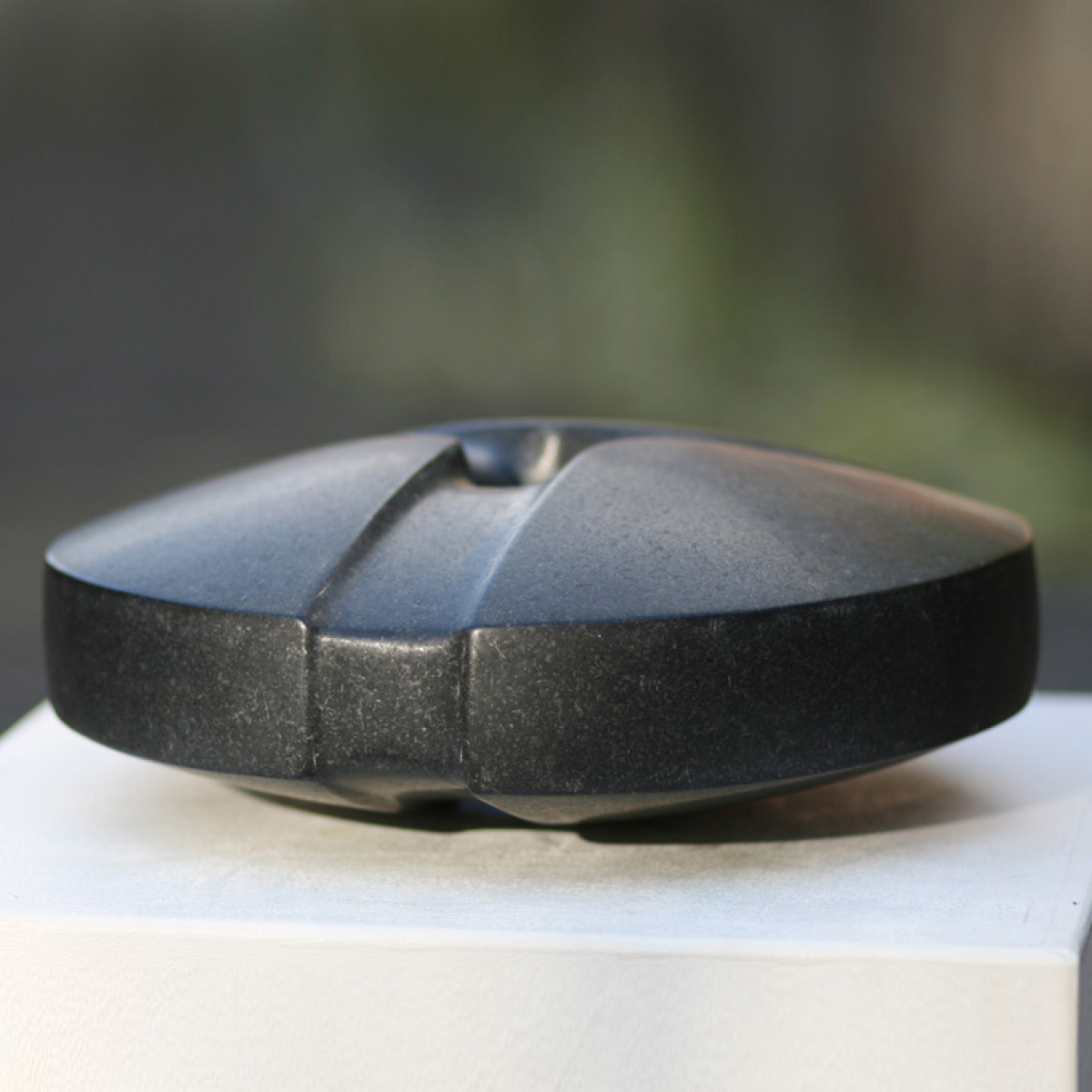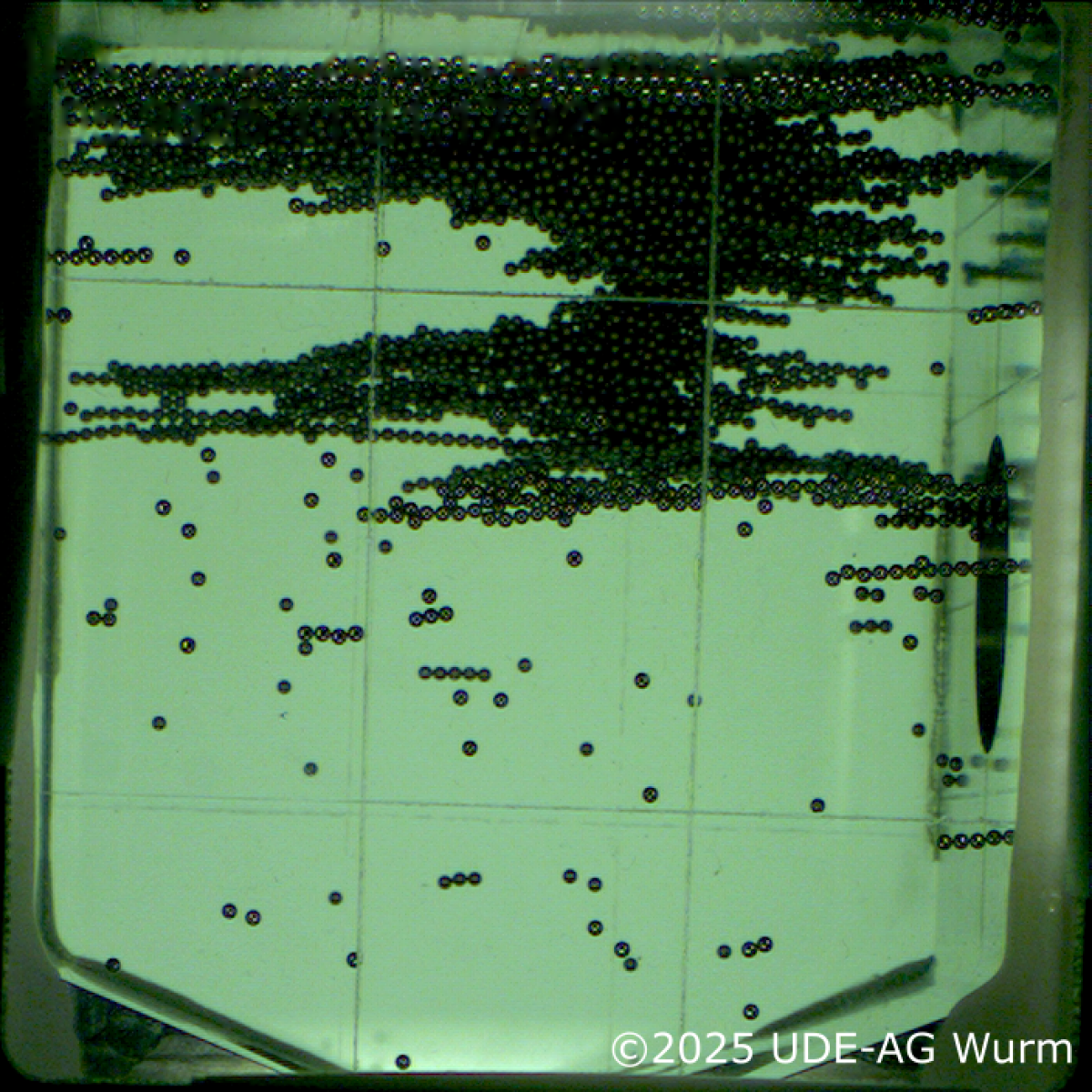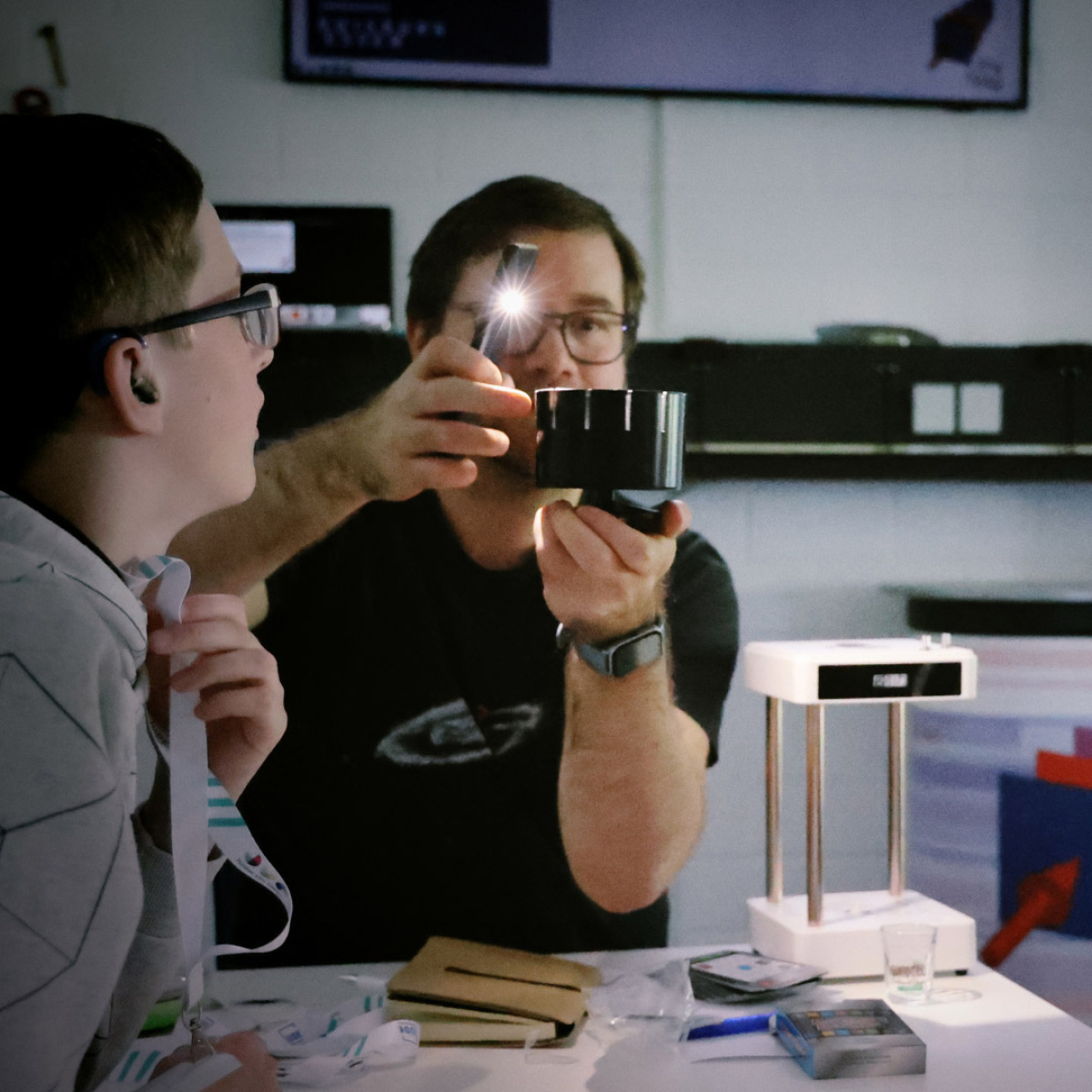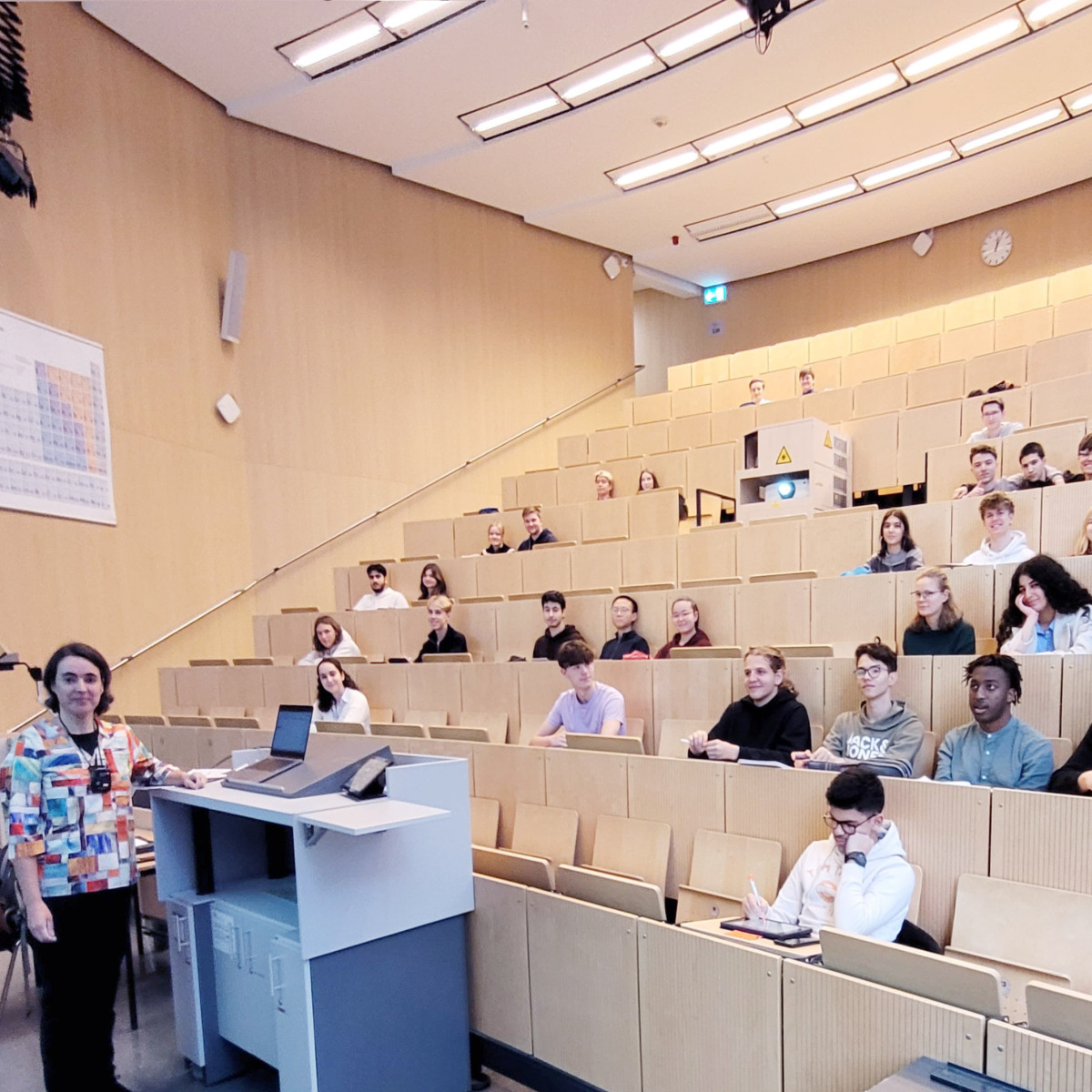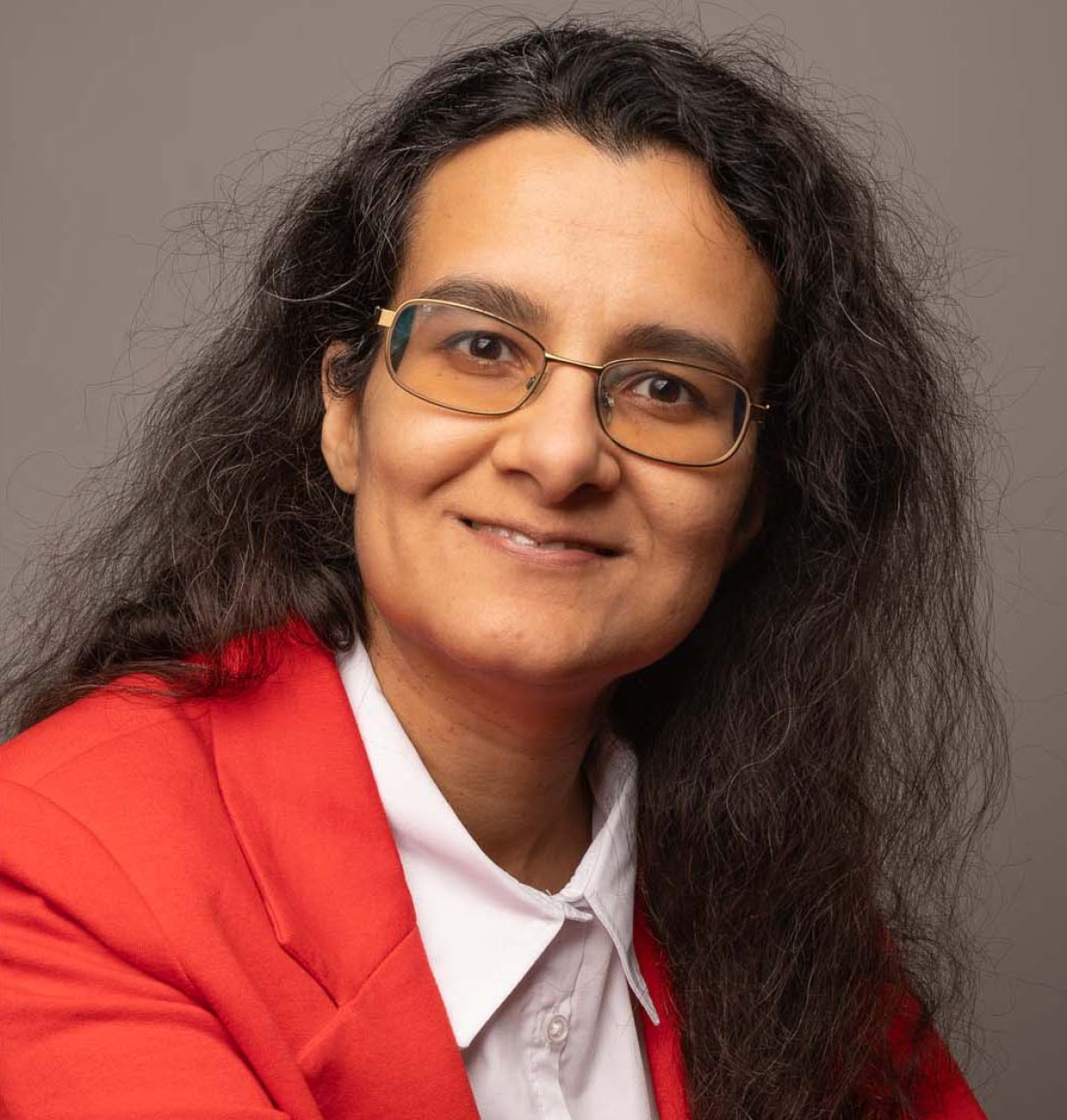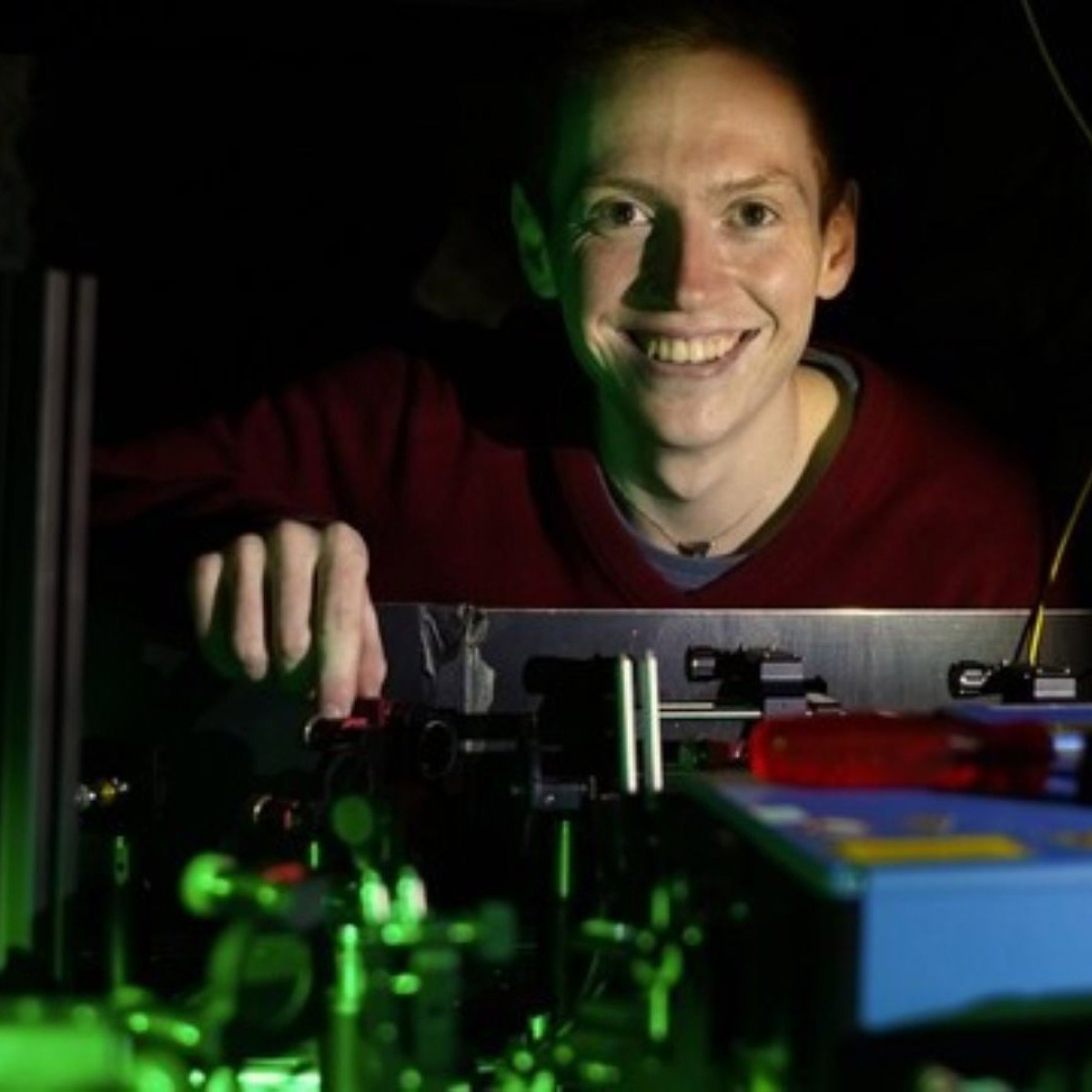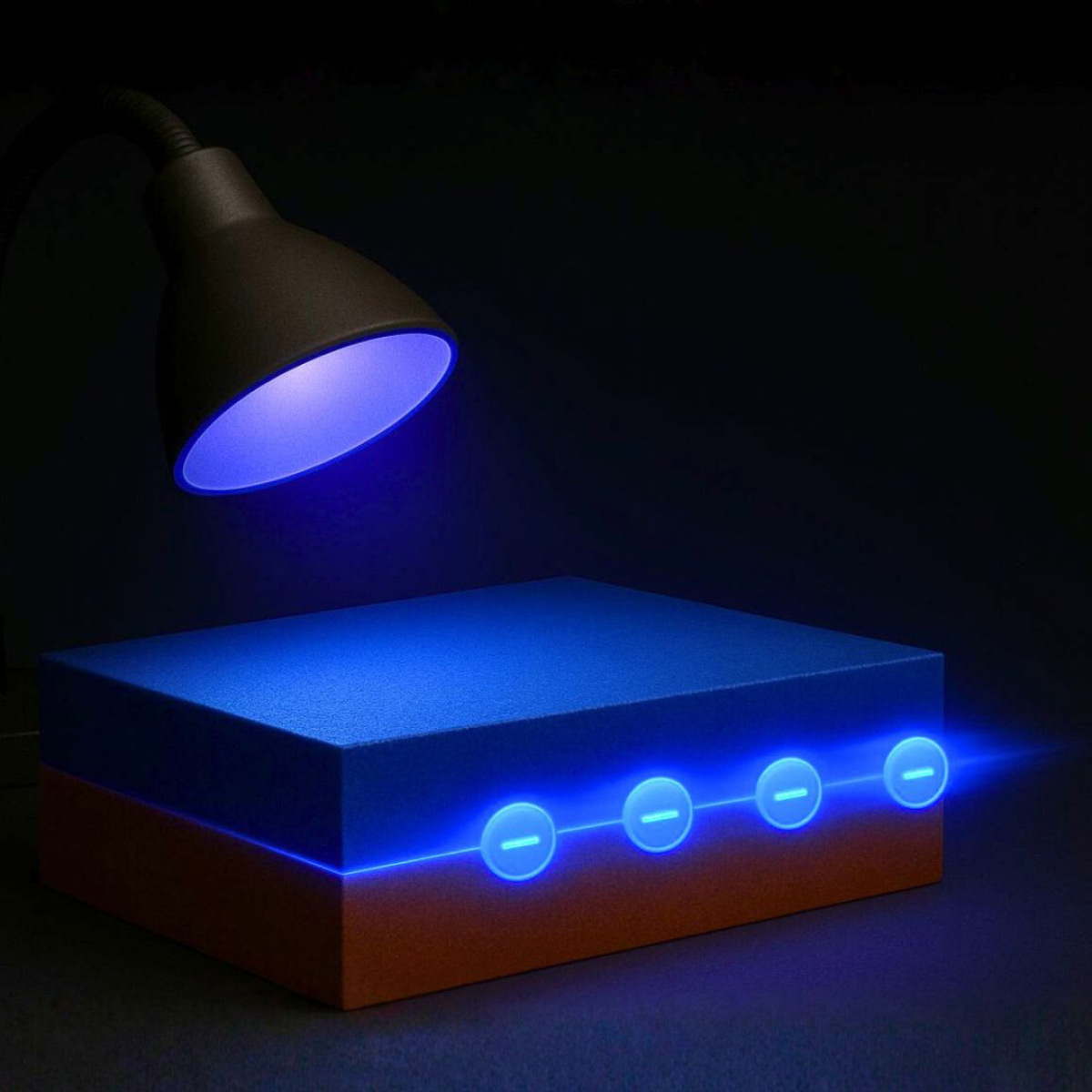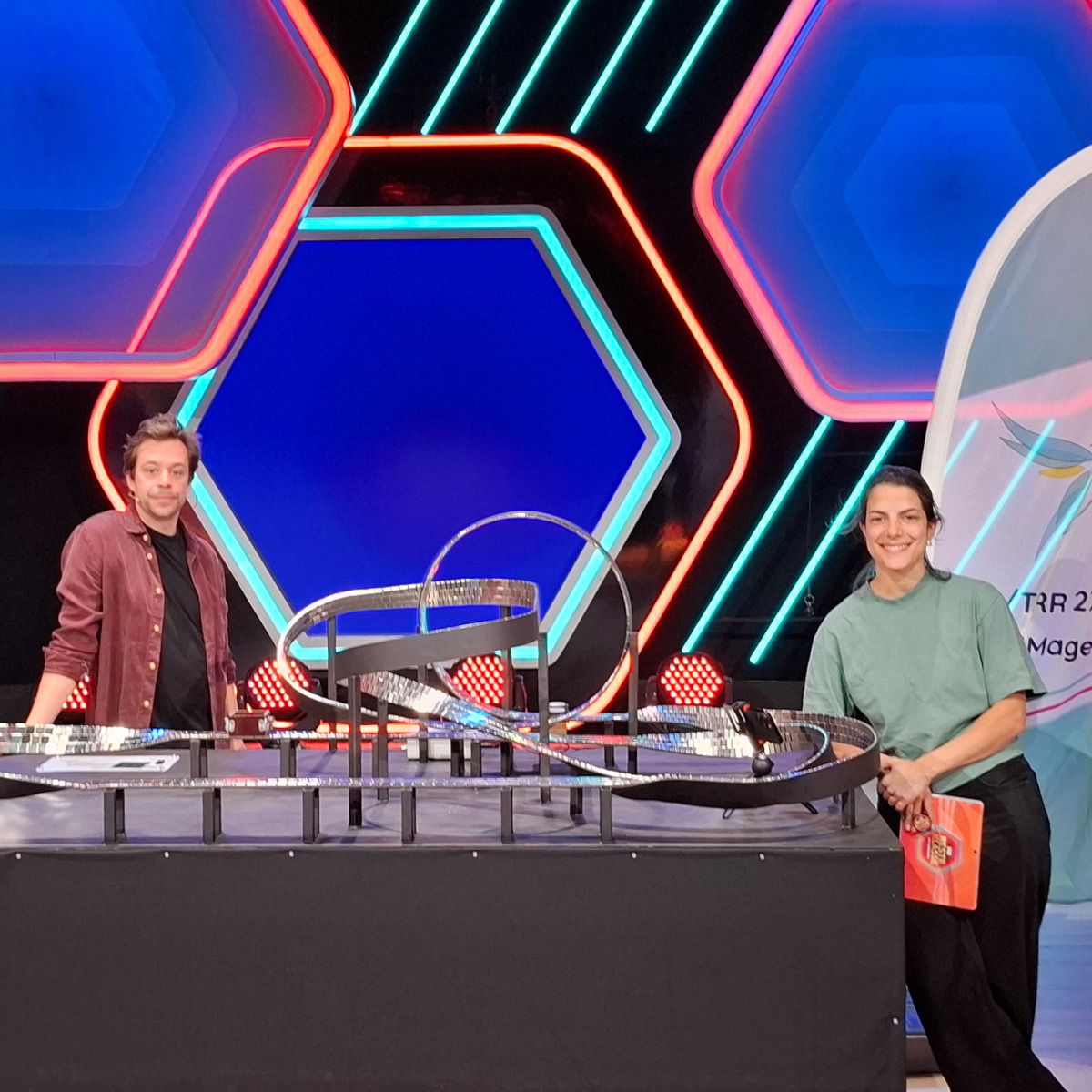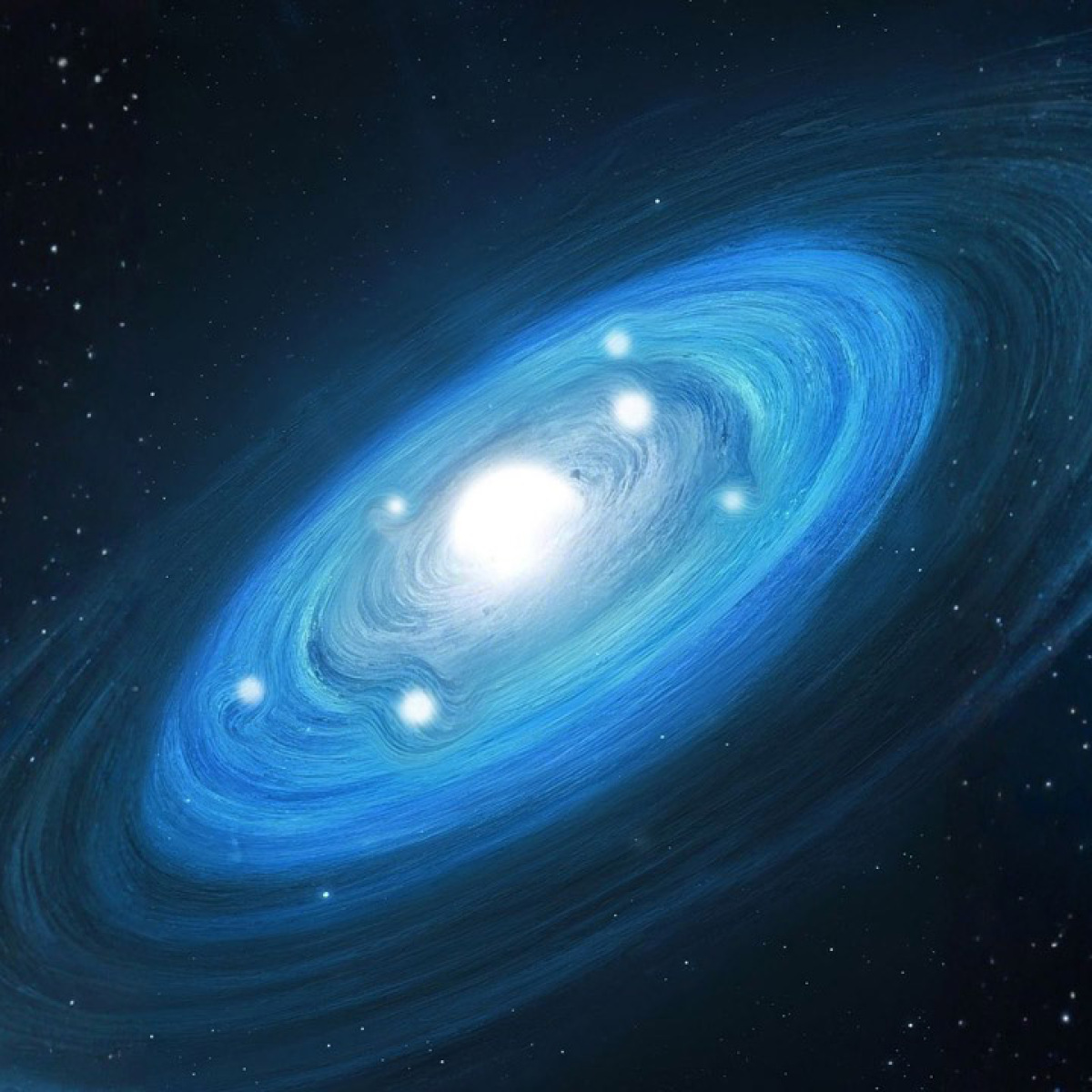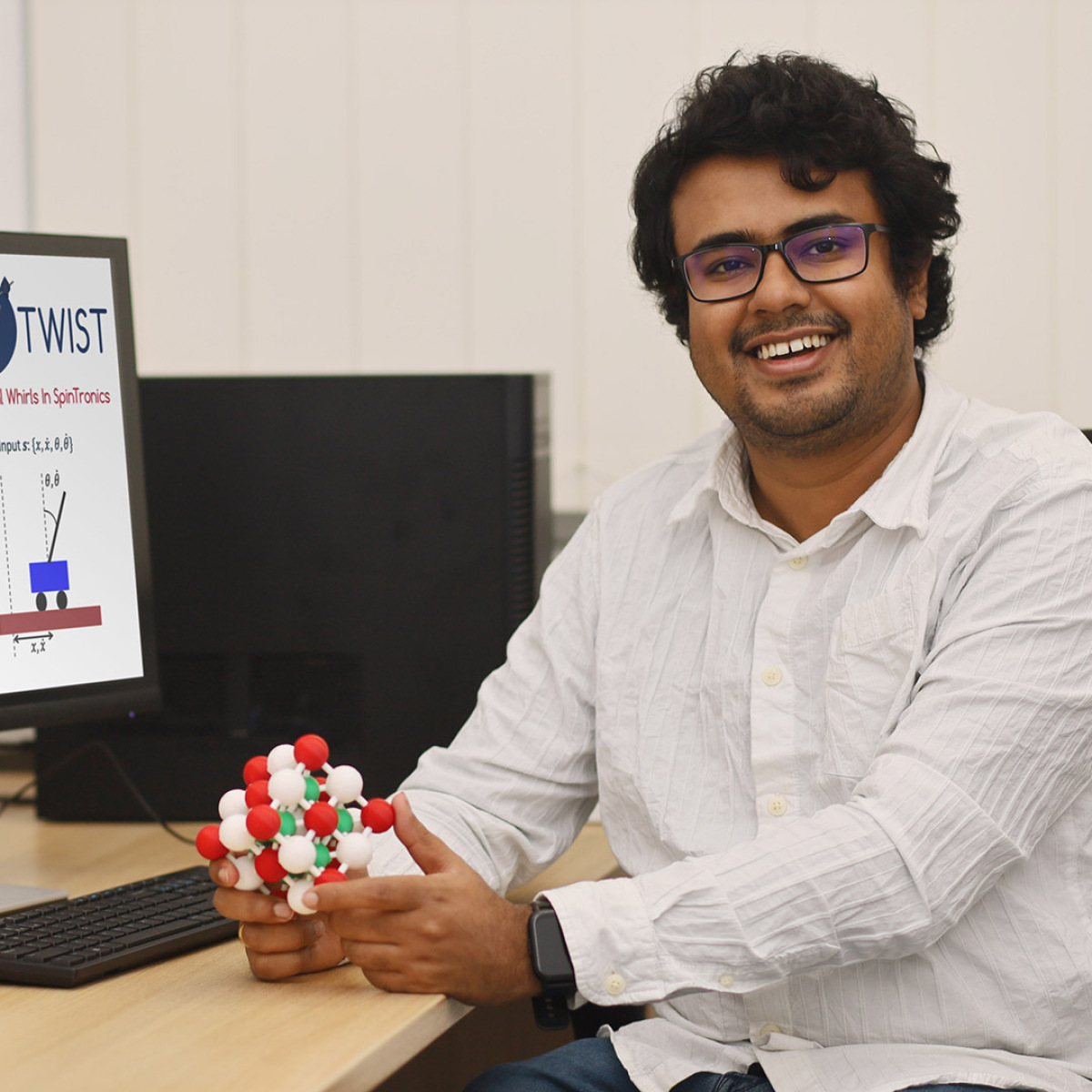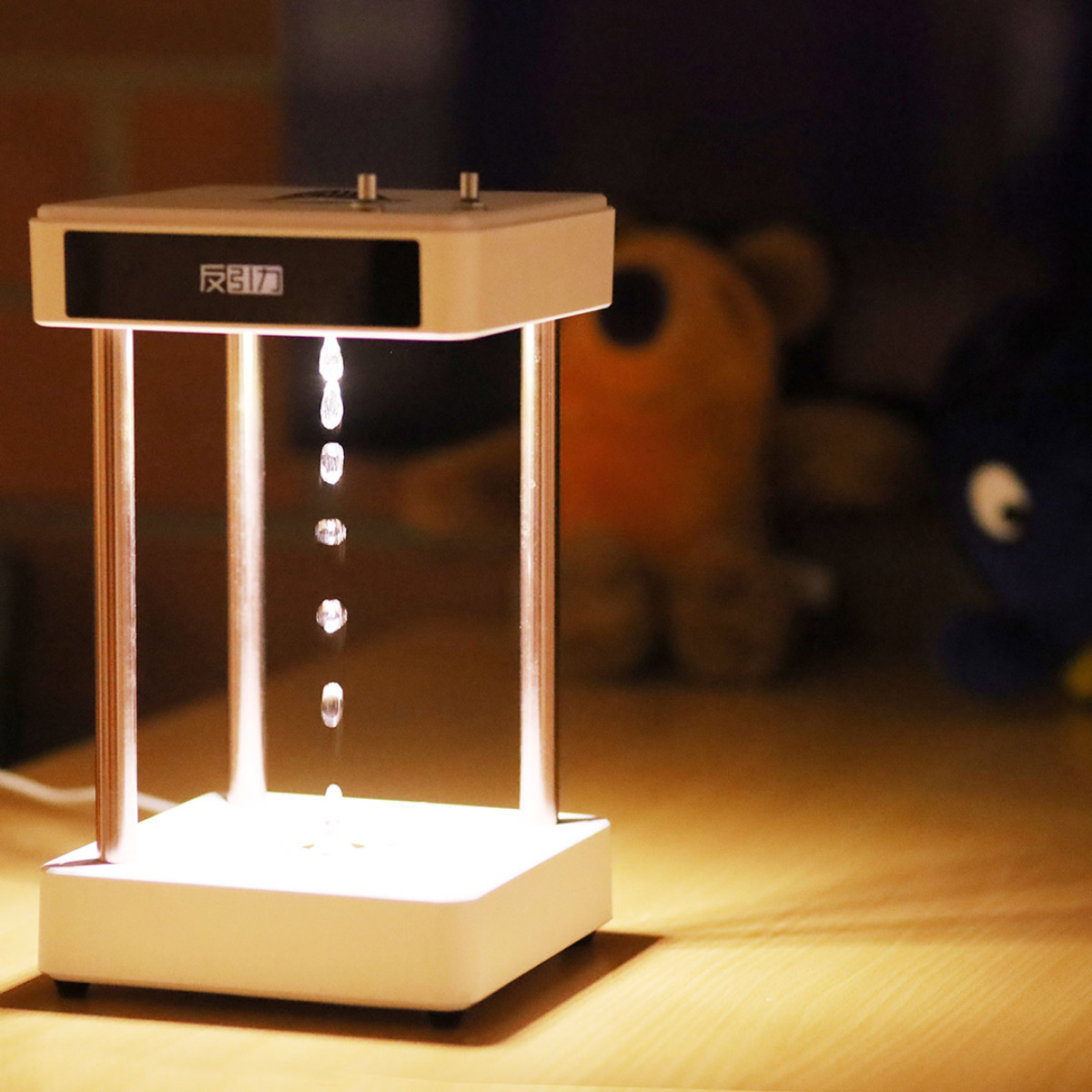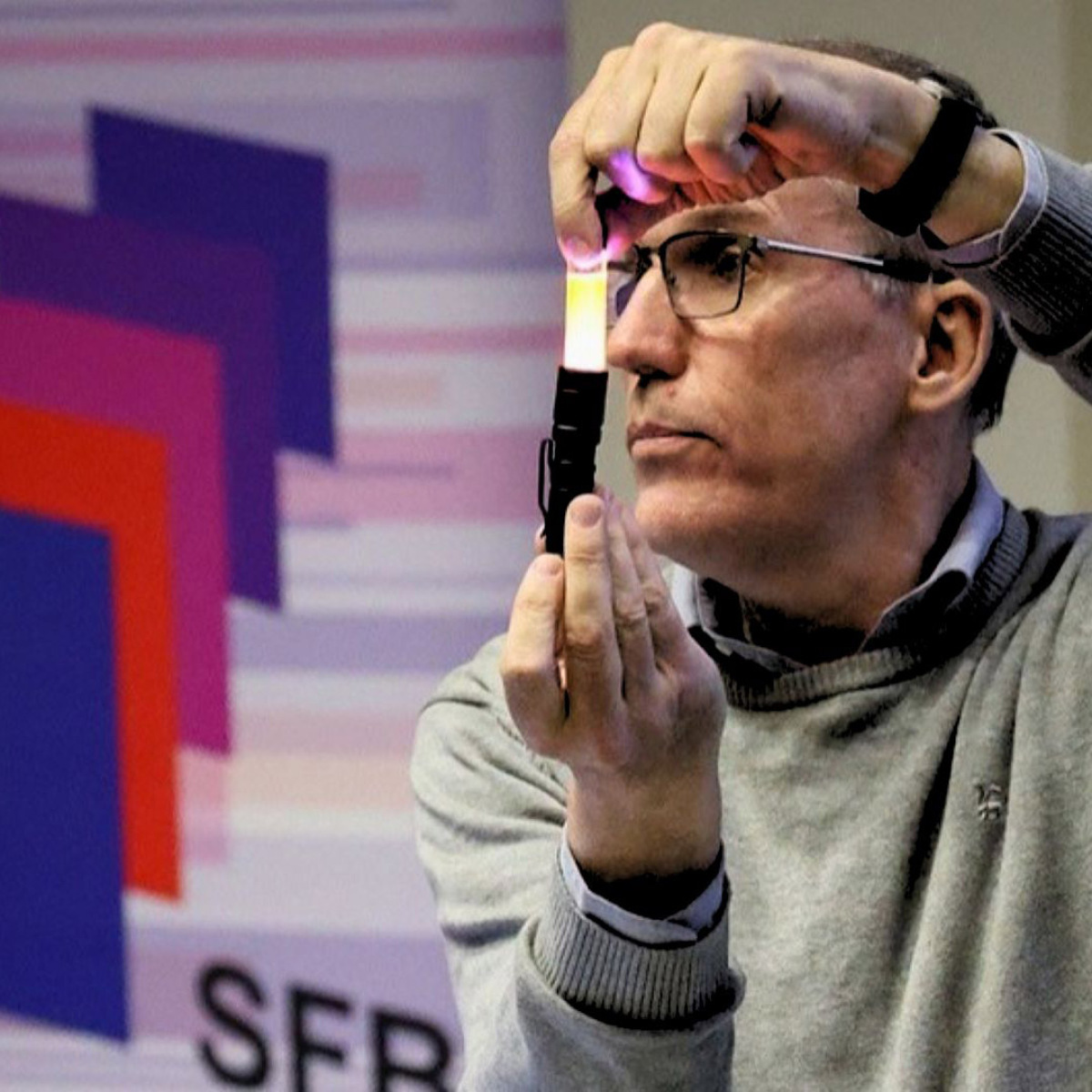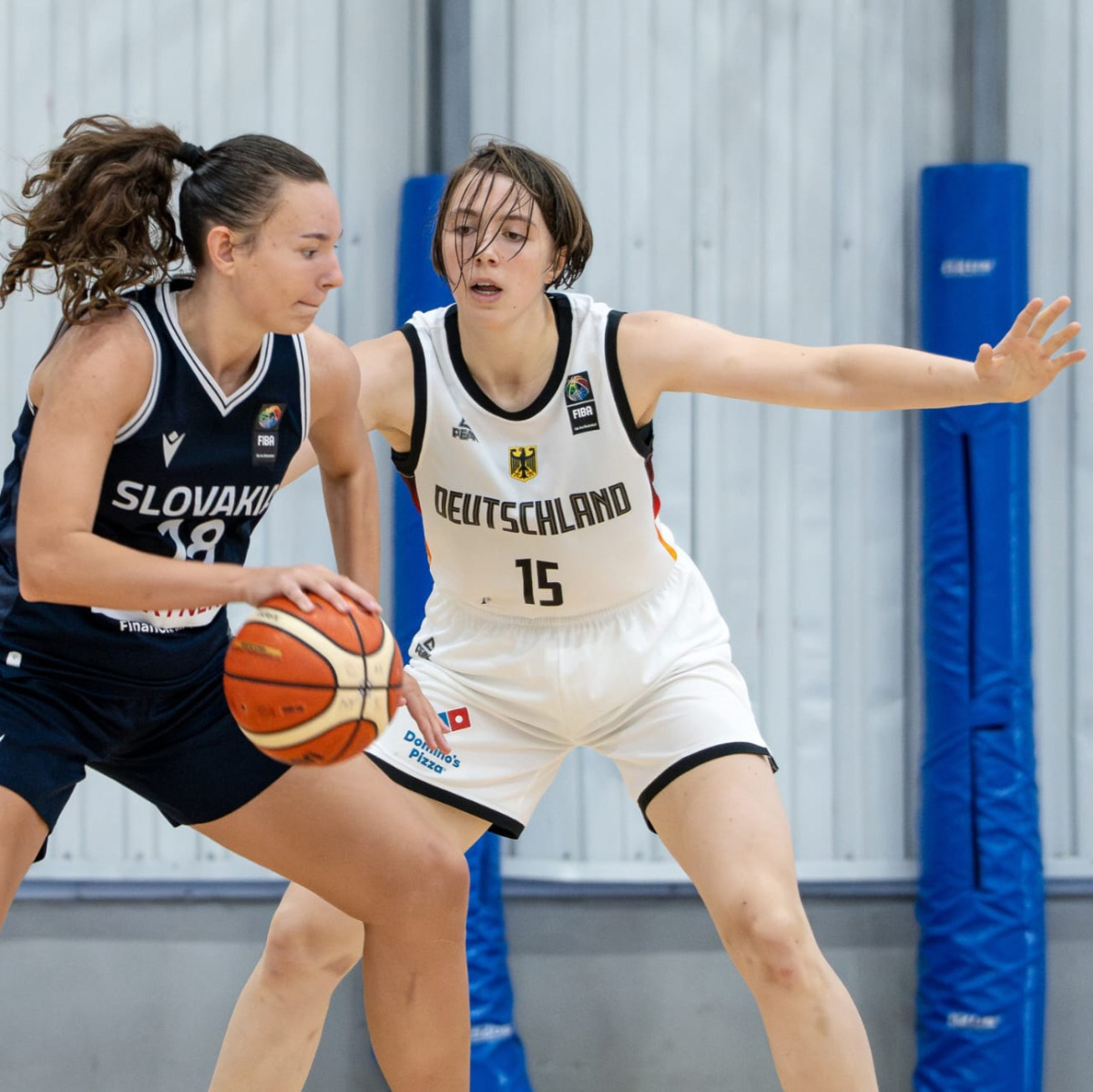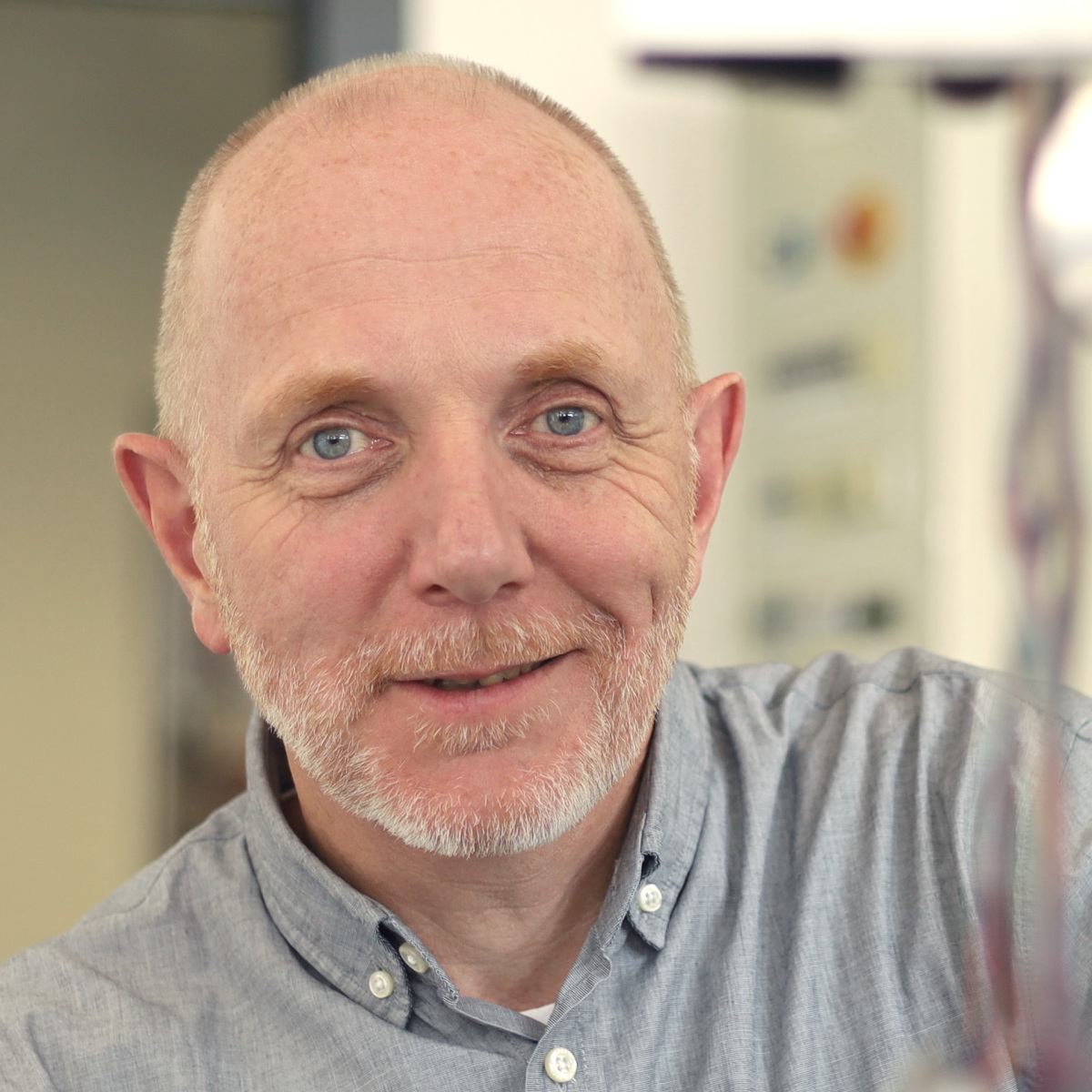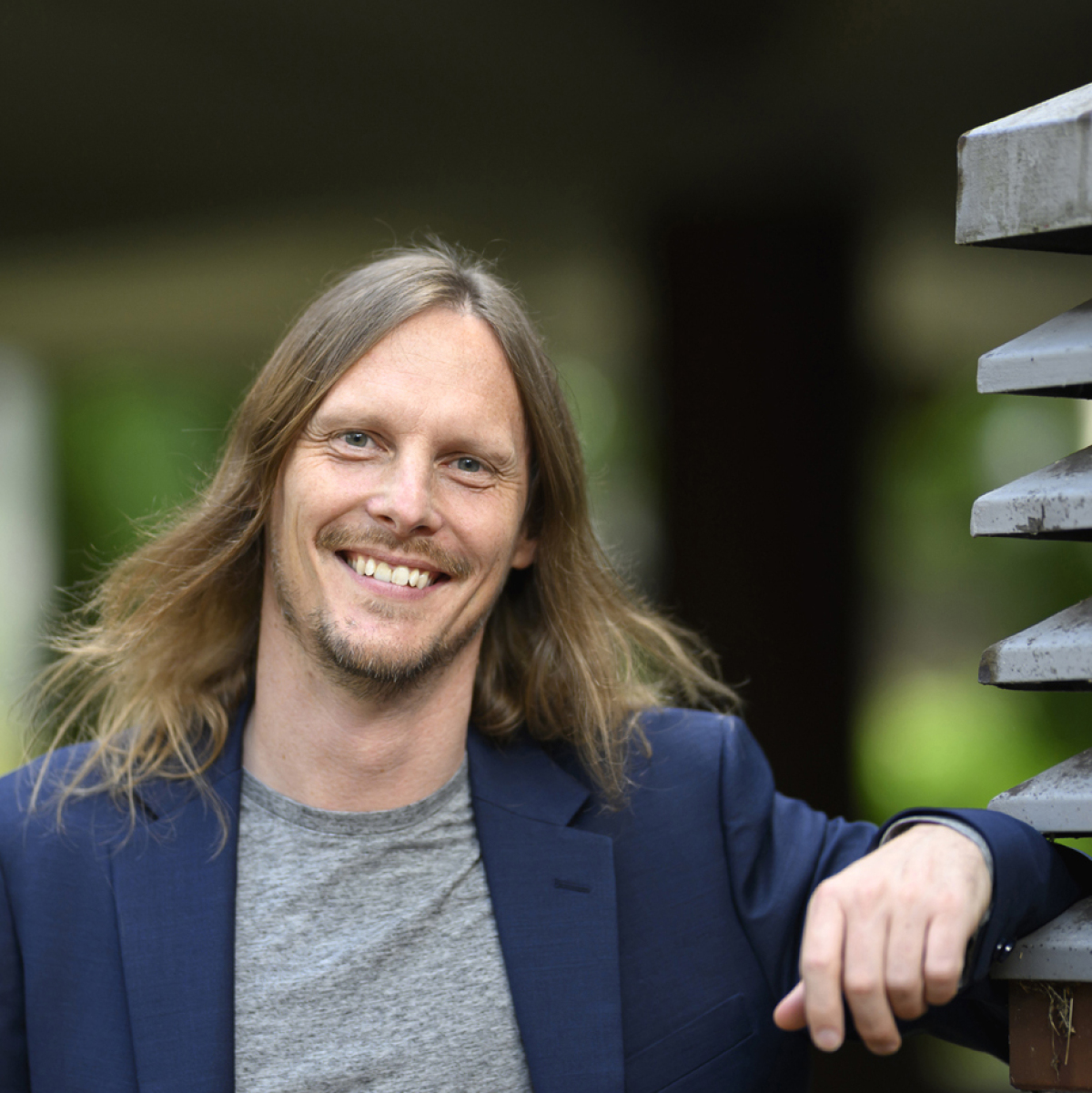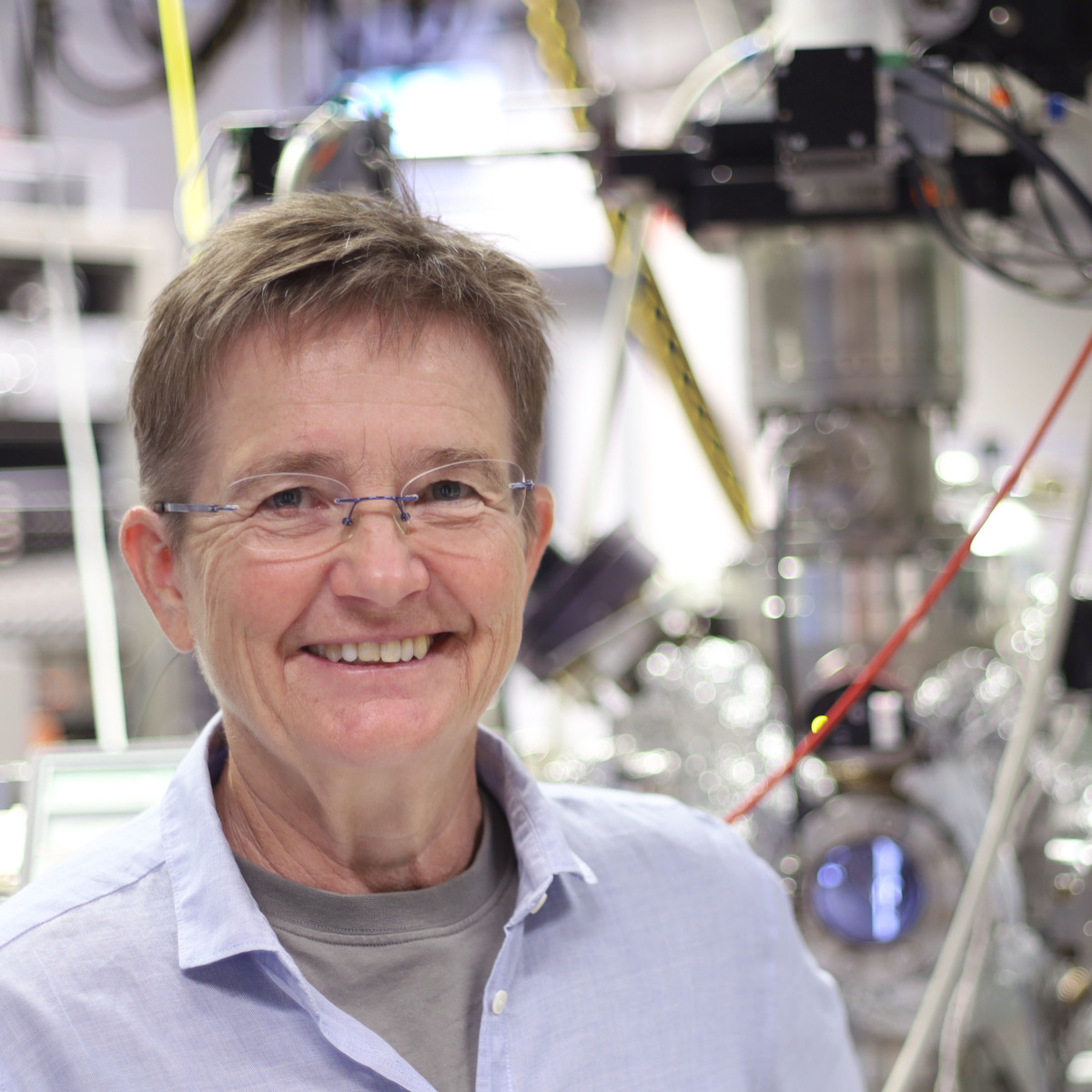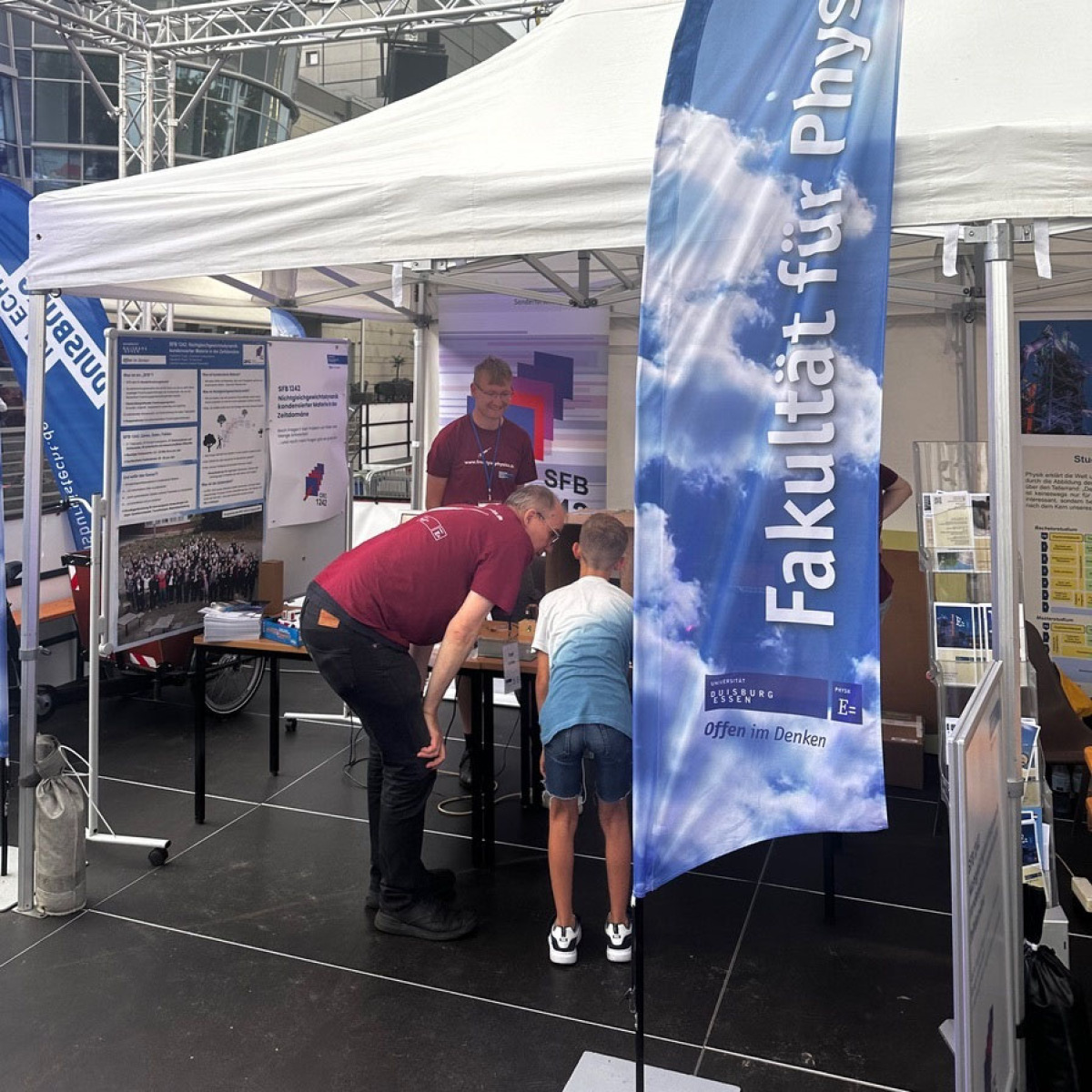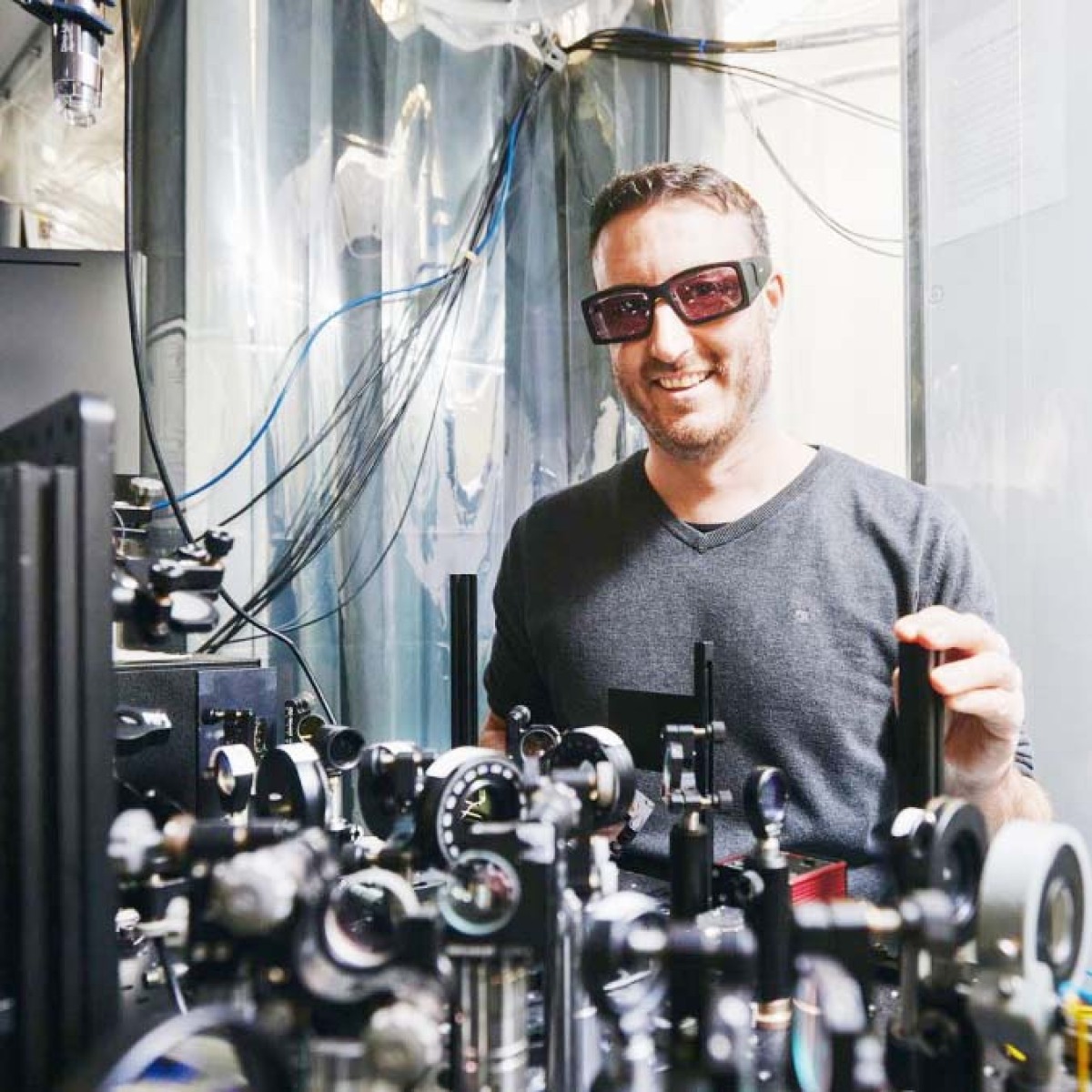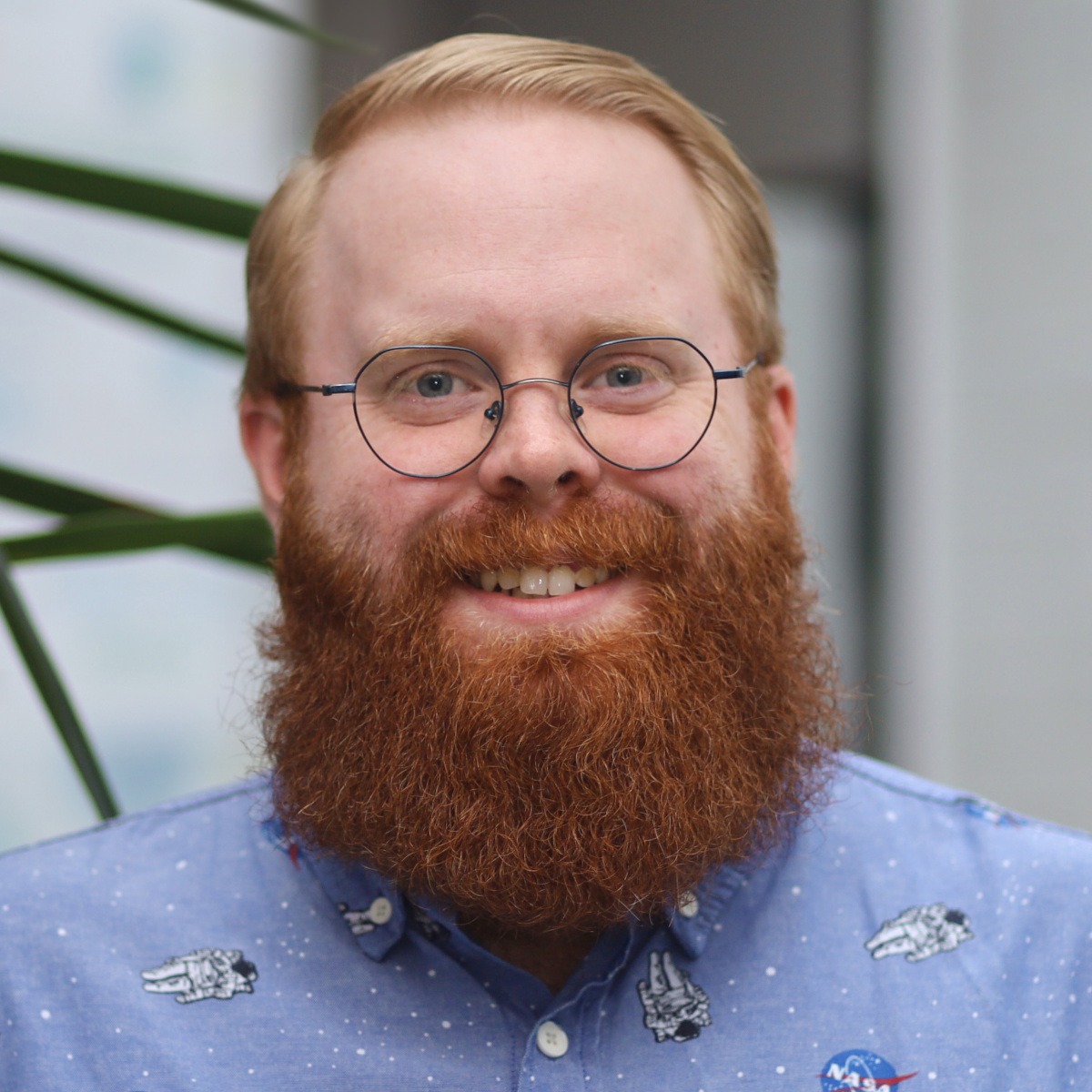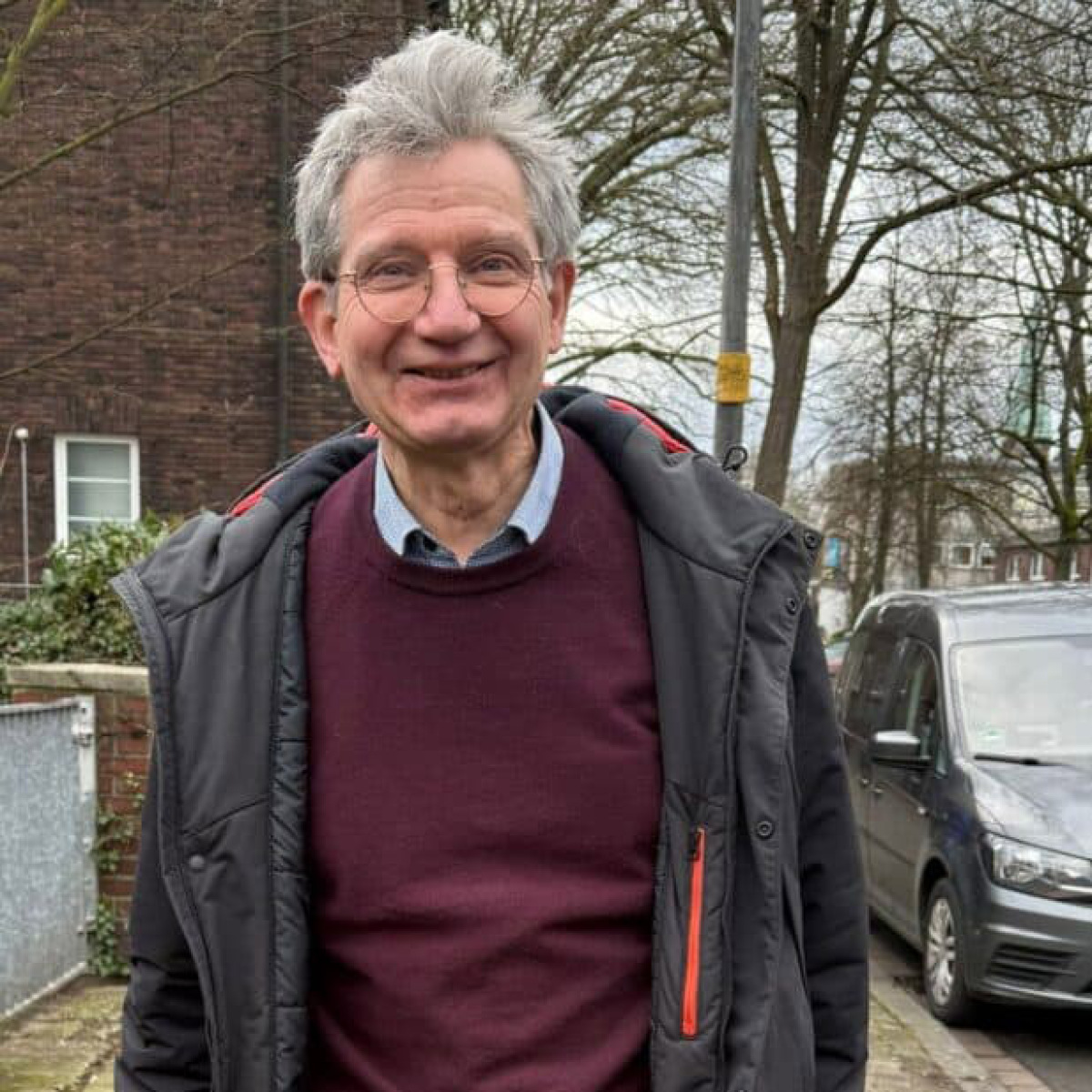News archive 2025
22.12.2025 New orientation semester in physics – get ready for your studies!
Physicists are in high demand on the job market, whether in the development of artificial intelligence, quantum computing, energy research, or teaching. To make it easier for prospective students to get started or to refresh the basics for physics students, the Faculty of Physics at the University of Duisburg-Essen has developed a new orientation semester. Registration for the free 12-week program is now open and will remain so until April 1st. The program will then start on April 27th, 2026.
Participants will repeat and deepen their knowledge of school-level mathematics and physics, thereby building a solid foundation. "Our goal is to ensure a relaxed and well-prepared start to their studies. Clear structures, a confident start to the subject, and enjoyment of the subject are crucial for this," explains Dean of Studies Prof. Dr. Hermann Nienhaus. There are also many opportunities to get to know future fellow students and find your way around campus before you start your studies. Classes take place in the so-called cookie tins on the Duisburg campus, close to the exciting laboratories and research topics.
The Physics Orientation Semester is aimed at prospective students of physics, energy science, and physics education. Students from other disciplines at the UDE and physics students who want to refresh their basic knowledge are also welcome. The program is particularly attractive for young people who want to ease their transition into university after a gap year.
The program does not require any compulsory exams. However, it is possible in some cases to take exams that will be recognized by the Faculty of Physics after enrollment in a regular degree program. Participants receive limited student status and benefit from library access and discounted cafeteria meals.
The orientation semester at a glance:
Start: April 27th, 2026 | End: July 23rd, 2026
Program days: Tuesday · Wednesday · Thursday (Pentecost holidays/free: May 25th–29th)
Registration deadline: April 1st, 2026
Places are limited. After April 1st, registration is only possible subject to availability.
Further information:
https://udue.de/osem
Dr. Anne-Kristin Pusch, anne-kristin.pusch@uni-due.de
Editor: Jennifer Meina, Tel. 0203/379-1205, jennifer.meina@uni-due.de
17.12.2025 Completely weightless! MAVERICK team's project accepted for the REXUS rocket programme!
Party atmosphere among the MAVERICK project team ‘We are incredibly proud and delighted that our MAVERICK project has been selected for the 17th cycle of the REXUS/BEXUS programme!’ On 24 and 25 November 2025, the team from Prof. Dr Gerhard Wurm's research group, consisting of Christopher Grünebeck, Kai Stuers, Nico Wenders and Gretha Swantje Völke, successfully participated in a selection workshop at the German Aerospace Centre (DLR) in Bonn. Their experiment on planetary formation is expected to travel aboard a nearly six-metre-long rocket in spring 2027, reaching an altitude of up to 80 kilometres above the stratosphere. The team will travel to Kiruna, Sweden, for two weeks to oversee the launch.
Tiny dust particles gradually form larger clumps until entire celestial bodies are created. What role do magnetic fields, which are omnipresent in the regions where young planets form, play in the early stages of planet formation? In the experiment, iron-containing or normal iron balls will be exposed to a magnetic field of a few mT in zero gravity. The zero gravity will last for two minutes.
‘We are looking forward to everything the project has in store for us in the future – from new insights to the launch in northern Sweden in 2027. The journey has only just begun!’
11.12.2025 NRW Returning Scholar Dr. Juba Bouaziz Quantum Materials for Future Computing
Traditional computers are reaching their limits in tasks such as pattern recognition and finding optimal solutions for large-scale systems. New technologies such as neuromorphic computing and quantum computing offer promising alternatives, but they require materials with novel magnetic and electronic properties. This is the focus of theoretical physicist Dr. Juba Bouaziz. At the University of Duisburg-Essen, he has found an excellent environment for pursuing this research. Thanks to the NRW Return Program, the 35-year-old is returning to Germany from Japan to establish his own junior research group.
Dr. Bouaziz develops entirely new materials for ultra-efficient computer architectures. More specifically, he designs structures for neuromorphic computing, which mimics the functioning of the human brain, and for quantum computing, which relies on the principles of quantum physics. These new components are no longer based on classical electronics but instead harness quantum-mechanical effects.
“My methodology is to use classical computers as a platform for discovering and designing quantum materials. To design and optimize materials for neuromorphic components, such as spintronic synapses, I use a multiscale approach that combines quantum simulations and machine learning,” Bouaziz explains. “For quantum computing applications, such as qubits—where every atom counts – I use high-performance computers and large-scale simulations involving hundreds of thousands of atoms. My research will provide a microscopic understanding and design rules for quantum materials, thereby supporting the development of energy-efficient neuromorphic hardware and scalable quantum computing technologies.”
The University of Duisburg-Essen provides him with an excellent scientific environment: With the Center for Nanointegration Duisburg-Essen (CENIDE), the Collaborative Research Center 1242 on non-equilibrium dynamics in quantum materials, and the Transregio 270 on magnetic hysteresis, Bouaziz finds a broad spectrum of complementary expertise. He maintains close links particularly with research groups working on density functional theory, quantum materials, and neuromorphic device concepts.
Bouaziz studied physics in Algeria and joined Forschungszentrum Jülich in 2014. He received his doctorate from RWTH Aachen University in 2019. He subsequently conducted research at the University of Warwick, Forschungszentrum Jülich, and most recently spent two years at the University of Tokyo. He has received several awards, including the Feodor Lynen Fellowship of the Alexander von Humboldt Foundation.
09.12.2025 The Faculty of Physics mourns the loss of its honorary doctor, Prof. Dr. Siegfried Großmann
Obituary by Prof. Dr. Stefan Thomae
On 21 November 2025, Professor Siegfried Großmann passed away in Marburg at the age of 95. With his passing, we have lost an outstanding researcher, teacher and scientific advisor. In recognition of his outstanding scientific achievements, particularly in the theory of hydrodynamic turbulence and nonlinear dynamics, the Faculty of Physics awarded him an honorary doctorate in 2006.
Siegfried Großmann studied in Berlin, first at the College of Education, then at the Free University, and after passing his second state examination, he taught at a secondary school in Berlin Tempelhof. After three years in teaching, he was offered an assistant position at the Free University and returned to academia. He completed his doctorate after one year with a thesis on the inelastic scattering of hydrogen molecules on hydrogen and qualified as a professor after two further years with a thesis on quantum mechanical transport equations. After a short period as a curator at the Technical University of Munich, he was appointed to a professorship at Philipps University in Marburg, where he gave his first ‘Hilbert space lecture’ on functional analysis in the winter semester of 1963/64.
His research focused on the physics of statistical non-equilibrium, the theoretical description of systems with many degrees of freedom in which large fluctuations occur. From this perspective, he investigated superconductors, lasers, liquids, gases and plasmas, chemical reaction-diffusion systems, heavy ion collisions, decaying atomic nuclei, turbulent flows and much more. His lectures were very popular with students because of their clarity and his excellent presentation skills, and because it was obvious that he himself enjoyed them. In addition, his commitment to the organisation and management of science was exceptional. As a reviewer, member and chair of numerous commissions and as a long-standing editor of scientific journals, he helped shape the scientific landscape as we know it today.
03.12.2025 Exhibition connects worlds – quantum physics and art
When two completely different worlds – art and quantum physics – collide, new perspectives emerge. This is clearly demonstrated by the national art and science project ‘Quantum meets Arts’. The German Physical Society initiated it on the occasion of Quantum Year 2025, and the UDE is one of four project locations. Eleven artists from the Rhine-Ruhr region are now presenting their creative exploration of quantum phenomena on the Duisburg campus. The exhibition can be viewed exclusively on Tuesday, 9 December.
The works include videos, sculptures, drawings and photographs. The artists drew inspiration for their works from the UDE quantum optics laboratories and from discussions with scientists. Barbara Koxholt, for example, shows photographs of everyday objects and places in which ‘double slits’ can be found. She thus alludes with a wink to the famous experiment that shows that light behaves like a wave. In contrast, Andreas Reichert's sculpture ‘Granitscheibe’ (see picture) takes up the shape of an orbital in an atom. Whereas it was once thought that electrons orbit the atomic nucleus in fixed paths, we now know that they are found in certain areas with a certain probability.
In addition to Barbara Koxholt and Andreas Reichert, the participating artists include Stacey Blatt, Christina Böckler, Susan Feind, Martin Gensheimer, Elisabeth Höller, Luise Hoyer, Kerstin Müller-Schiel, Sigrid Neuwinger and Peter Steinebach.
Video of the event by Nicolas Wöhrl
When: Tuesday, 9 December 2025, from 10 a.m. to 7 p.m.
Public reception: 5 p.m.
Where: Foyer of Lecture Hall MC, MC Building, Duisburg Campus
Further information: stacey.blatt@uni-due.de
20.11.2025 Two minutes of weightlessness – team from Prof. Wurm's research group applies for rocket flight for their experiment
A team from Prof. Dr. Gerhard Wurm's research group has been invited to a workshop at the DLR in Bonn on Monday and Tuesday, 24 and 25 November 2025 – Christopher Grünebeck, Kai Stuers, Nico Wenders and Gretha Swantje Völke.
Workshop at the DLR in Bonn. With a 25-minute presentation, they are applying for a rocket flight for their experiment. They have already made it to the final round. The aim is to investigate the magnetic growth of protoplanets by exposing iron-containing or even normal iron balls to a magnetic field of a few mT in zero gravity. The zero gravity will last for two minutes.
The expected launch date is spring 2027, when we as a team would travel to Kiruna for two weeks to supervise the launch.
MAVERICK: A new look at the formation of planets How do planets actually form? Tiny dust grains gradually form larger clumps – until finally entire celestial bodies are created. But this process reaches its limits early on: collisions alone do not allow particles to grow indefinitely. This is precisely where the MAVERICK project at the University of Duisburg-Essen comes in.
The team is investigating a question that has received little attention in research to date: What role do magnetic fields play in the formation of the first solid structures in space? Such fields are omnipresent in the regions where young planets form. However, whether and how they hold dust particles together or influence their growth remains largely unclear.
To find out, MAVERICK aims to test the stability of magnetically connected particle aggregates under space conditions. The decisive factors are how large such aggregates can become and what factors determine when they grow – and when they disintegrate again. For this purpose, the project is participating in the selection round for the REXUS 37/38 rocket campaign. A suborbital rocket flight offers ideal conditions for observing the particles in a state of weightlessness and precisely measuring their development.
The team is currently looking for supporters and scientific partners who would like to accompany the project. Interested parties can contact MAVERICK directly to learn more about the experiment and help advance research into early planet formation.
18.11.2025 Experiment, marvel, understand – Night of Physics in Duisburg
by Juliana Fischer
At the Night of Physics at the University of Duisburg-Essen, visitors can once again research, build and marvel to their heart's content. On 21 November from 5 p.m., the Faculty of Physics on the Duisburg campus (Lotharstraße 1) will open its doors. Children and adults can try out experiments, visit laboratories and discover how exciting science can be in everyday life until 11 p.m. Admission is free and registration is not required.
With experiments, laboratory tours and lectures, UDE researchers will spark curiosity and enthusiasm for physics: in the ‘fastest laboratory in the world’, the school laboratory of the Collaborative Research Centre 1242, light becomes a tool – laser beams stop time, flashes of light measure fractions of a second, and visitors can play in the laser maze. In addition, children aged ten and above can get hands-on themselves: they grab cables, wire and screwdrivers and transform a simple brush into a small racing car in no time at all, or build a solar-powered toy car.
The research laboratories will be opening their doors throughout the evening: in the clean room, visitors can watch how tiny computer chips are made from semiconductors – from lithography to ultra-thin materials. Other experiments take you into space: experiments on gravity and gravitational force show how planets grow from microscopic dust particles. And if you want to know how to set electrons in motion, the guided tour ‘Hunting electrons with terahertz radiation’ shows you how infrared rays make invisible particles visible.
Starting at 7 p.m., physicists from the UDE will give lectures on the core topics of physics – from space to the quantum world. Dr. Jens Teiser explains why the hourglass stops on the moon, while Prof. Dr. Axel Lorke and Prof. Dr. Klaus Hornberger take us into the world of this year's Nobel Prize in Physics. Afterwards, the focus will shift to everyday life: Dr Florian Mazur will talk about the optimisation of airports, and Prof. Dr Hendrik Härtig will discuss political education in physics lessons.
Anyone who wants to start studying after being amazed will find contact persons for physics, physics teaching and energy science in the foyer. Teachers and students report on their everyday lives, explain the buddy system and answer questions about applications, course progression and career prospects – without any formulas, but with a lot of enthusiasm.
The event is also accessible by wheelchair, walker or pram.
17.11.2025 What is it like to study physics? The trial physics course gives you a good insight!
On 8 November 2025, 53 school pupils began their trial course at our Faculty of Physics. On 14 March 2026, after 15 sessions – always on Saturdays – they will know exactly whether they will start a regular degree in physics, a teacher training degree in physics or a degree in energy science with us.
The trial study programme deals with the topic of oscillations and waves. Experimental and theoretical lectures are offered, as well as exercises and a practical course. For 25 years, the Faculty of Physics at the University of Duisburg-Essen has been offering this opportunity to gain an objective impression of the programme. It is unique in Germany in this respect. Reason enough for some trial students to travel more than a hundred kilometres to attend.
Dr Ana Vila-Verde started the series with three lectures on mathematics for physicists.
13.11.2025 Hertha Sponer Prize 2026 – Physicist Maria Azhar honoured
by Cathrin Becker
She is an absolute expert when it comes to magnetic patterns in materials: Dr Maria Azhar is being honoured with the Hertha Sponer Prize from the German Physical Society for her research in the field of topology in magnetism. The jury particularly highlighted the great originality with which the physicist from the University of Duisburg-Essen has made important contributions to the understanding of complex spin structures in magnetic materials.
Dr Maria Azhar studied physics in Islamabad and then completed the Top Master Nanoscience programme at the University of Groningen. She subsequently obtained her doctorate there under Prof. Maxim Mostovoy on non-collinear magnetism. She also conducted research as a research assistant at the Karlsruhe Institute of Technology before moving to the UDE as a postdoctoral researcher in August 2023.
Here, in Prof. Karin Everschor-Sitte's ‘TWIST – Topological Whirls In SpinTronics’ working group, she is continuing her excellent research work in the field of topological 3D magnetic structures, which has further advanced the understanding of topology in magnetism, complex magnetic phases and their possible applications.
For this and other research achievements, she has now been honoured by the jury of the Hertha Sponer Prize: Maria Azhar provided fundamental insights into non-collinear magnetism during her doctoral studies and predicted screw dislocations in helical magnets in further work. ‘Most recently, she has made a significant contribution to the topological classification of three-dimensional magnetic structures, which is shaping international developments in the field,’ the jury stated.
The Hertha Sponer Prize is awarded to a female scientist for outstanding scientific work in the field of physics. The prize is intended to encourage younger female scientists in particular through public recognition, thereby attracting more women to physics. The award consists of prize money of €3,000 and a certificate.
Dr Maria Azhar will be presented with both on 17 March 2026 during the 89th Annual Meeting of the German Physical Society in Erlangen.
22.10.2025When disturbances become useful – Quantum noise in the tunnel effect tamed
by Jennifer Meina 16 October 2025
What is normally considered a disturbance can be surprisingly useful under certain conditions: noise. Researchers at the University of Duisburg-Essen have shown how the random noise caused by the quantum mechanical tunnel effect – a phenomenon that is also the focus of this year's Nobel Prize in Physics – can be specifically influenced. The results, now published in Communications Physics, open up new perspectives for future quantum devices.
Hi-fi enthusiasts hate it, and it makes the work of electronics engineers difficult: noise – unwanted, random interference from the environment that overlays and distorts the actual signal. But noise can also be useful and amplify processes. The mechanism behind this is ‘stochastic resonance’. In this phenomenon, small random fluctuations amplify what is actually a weak signal, making it clearer and more regular.
a collaboration combining experiment and theory, the research groups led by Prof. Dr. Axel Lorke and Prof. Dr. Jürgen König at the University of Duisburg-Essen (UDE) have now succeeded in observing stochastic resonance in a quantum phenomenon. Using high-resolution laser spectroscopy, the research groups tracked the movement of a single electron that can either be located in a tiny nanostructure (a ‘quantum dot’) or outside it in an electron reservoir. There is a barrier between the reservoir and the quantum dot, but the electron can penetrate it due to the quantum mechanical tunnelling effect. ‘If you throw a ball against a barrier, it will bounce back. In the quantum world, however, an electron can penetrate the barrier with a certain probability and thus reach the other side. This is possible because particles also behave like waves. This is the tunnelling effect,’ explains Lorke.
The tunnelling process, the research into which was awarded this year's Nobel Prize, is completely random and thus represents a source of noise for electron movement. However, by applying a small alternating voltage, this random movement could be tamed so that the electron oscillated back and forth between the quantum dot and the electron reservoir in a much more regular manner.
To demonstrate this, millions of tunnel processes were analysed over time using sophisticated statistical methods. Surprisingly, the best suppression of random motion does not occur at the frequency that would be expected according to the usual explanations of stochastic resonance. Depending on the strength of the alternating voltage, it was sometimes even significantly lower. This phenomenon is not yet fully understood and opens the door to further investigation.
The work of the Duisburg physicists is relevant for visionary quantum components, such as tap-proof communication channels in which individual bits need to be sent as regularly as possible.
In the picture: The working groups (here doctoral student Hendrik Mannel) used laser spectroscopy to investigate how noise influences the tunnel effect.
16.10.2025Researchers create conductive interface in nickelate materials – Light Switch for Electrons
von Juliana Fischer
Using ultraviolet (UV) light, scientists have succeeded in switching an extremely conductive state on and off within seconds at the interface between two oxide materials. This newly discovered ‘light switch for electrons’ is a significant step towards light-controlled electronics and could also play a role in superconductivity one day. The findings have been published in Nature Materials. The international research team includes theoretical physicist Professor Rossitza Pentcheva (University of Duisburg-Essen) and her former colleague, Dr Benjamin Geisler (University of Florida).
‘The key aspect of our work is that an exceptionally conductive state can be switched on and off solely by light – almost like flipping a switch,’ says Professor Pentcheva from the Department of Physics at the University of Duisburg-Essen (UDE). ‘This opens up new possibilities to manipulate superconductivity in nickelates using ultrafast light pulses.’
At the centre of the investigation is NdNiO₂, a representative of the so-called infinite-layer nickelates. This class of materials is similar to copper oxide high-temperature superconductors and has gained increasing attention in recent years, as it becomes superconducting under specific conditions.
Already in 2020, Geisler and Pentcheva predicted that a so-called two-dimensional electron gas could form at the interface between the nickelate NdNiO₂ and the insulator strontium titanate (SrTiO₃) – an extremely thin layer in which electrons move almost without resistance. Such states are considered key to future developments in nanoelectronics, spintronics and quantum information. However, in previous experiments this electron gas did not appear, since the atoms at the interface mixed more strongly than expected – as shown in a collaborative study by Cornell, Stanford and Duisburg-Essen Universities published 2023 in Nature Materials.
The international research team now employed light as a targeted stimulus: in their experiments, they illuminated the interface with ultraviolet light while simultaneously measuring its electrical conductivity. In parallel, Geisler and Pentcheva carried out quantum-mechanical simulations on UDE’s supercomputer to precisely describe the behaviour of the electrons.
‘When the light is switched on, the material changes abruptly: its electrical resistance drops by up to a factor of a hundred thousand – the sample suddenly conducts around 100,000 times better,’ Pentcheva explains. The effect is caused by a tiny electric field at the interface, which channels the UV-induced electrons along an invisible track into an ultrathin layer. There, they move with remarkable ease and form a highly conductive electron gas. As soon as the light is switched off, the state disappears completely – the material returns to its original condition without any lasting change.
Caption: Light on – current on: UV radiation transforms the material’s interface into a highly conductive electron layer.
13.10.2025Magnetic levitation train from our CRC/TRR 270 featured on the television programme ‘Die beste Klasse Deutschlands’ (Germany's Best Class)
Magnet researchers from the University of Duisburg-Essen supported the grand finale of ‘Die beste Klasse Deutschlands’ (11 October 2025 at 8:20 a.m. on ARD) with an experiment. The magnetic levitation train shown demonstrates the levitation of a superconductor above a track of permanent magnets. The experiment was built as part of the DFG-funded project SFB//TRR 270 HoMMage in order to communicate research to a broad public. Dr Nicolas Josten from Professor Michael Farle's research group travelled to the KinderMedienZentrum studio park in Erfurt to support Bavaria Entertainment during filming. The show is hosted by Clarissa Corrêa da Silva and Tobias Krell and features three school classes competing for the title of Germany's best
09.10.2025Article in Nature Astronomy confirms theory – Rare septuple star system discovered
by Jennifer Meina
It is an extremely rare phenomenon in space: a system consisting of seven young stars. An international research team, including Prof. Dr. Rolf Kuiper from the University of Duisburg-Essen, made this discovery. The team has now published its findings in the renowned journal Nature Astronomy. They provide an explanation as to why the instability of gas discs is crucial for the formation of these multiple systems.
Multiple stellar systems are of great importance in astronomy: on the one hand, they can lead to astronomical phenomena – such as X-ray binaries, gamma-ray bursts, supernovae and star mergers, which are important sources of gravitational waves. On the other hand, they influence the dynamics of star clusters.
‘These are large groups of stars that originated from the same cloud of gas and dust and remain bound together by gravity. All stars in a cluster are roughly the same age and have a similar chemical composition,’ explains Prof. Dr. Rolf Kuiper, head of the Numerical Astrophysics Working Group at the University of Duisburg-Essen (UDE). The newly discovered system, whose stars are still forming, is located in the star-forming region NGC 6334I(N) – a particularly active part of the so-called ‘Cat's Paw Nebula’, where many massive stars are currently being ‘born’.
However, how systems with many stars actually form has been poorly understood until now. The researchers' stability analysis now shows that the gas disc containing the septuple system is dynamically unstable. This means that the gravitational force within the disc is stronger than the forces that could actually keep it stable (e.g. rotation or pressure). As a result, the disc ‘breaks’ apart into individual fragments, each of which can condense into stars. ‘Our observations clearly show for the first time that a breaking, unstable gas disc can actually produce several stars at the same time. We can now confirm a mechanism that was previously only suspected in theories, and we can now deepen our work in a more targeted manner,’ explains the astrophysicist.
Graphic: Seven young stars have formed in the rotating gas disc. This unusual system provides new insights into the formation of highly complex star systems.
Further information:
The study can be found here.
Prof. Dr Rolf Kuiper, Working Group for Numerical Astrophysics, rolf.kuiper@uni-due.de
07.10.2025Atreya Majumdar receives Add-on Fellowship from the Joachim Herz Foundation - Funding for outstanding early-career research
Atreya Majumdar, from the working group of CENIDE member Prof. Dr. Karin Everschor-Sitte, has been accepted into the "Add-on Fellowship for Interdisciplinary Science and Transfer" of the Joachim Herz Foundation for the year 2025. The award is given to up-and-coming young researchers whose work at the interface of different disciplines promises high potential and social relevance.
The fellowship program promotes excellent scientists in the economic, life and engineering sciences. Over a period of two years, the fellows receive financial support of up to 15,000 euros for their research as well as access to an exclusive scientific network. A fundamental component of the program is also further training opportunities that specifically strengthen the transfer of scientific knowledge to society and the economy.
The selection of Atreya Majumdar underlines the high quality and forward-looking orientation of his work. The Joachim Herz Foundation's support will enable him to further advance his promising research work and gain new perspectives through interdisciplinary exchange.
A central aim of the Joachim Herz Foundation's funding is to strengthen the scientific independence of promising researchers. The targeted exchange across disciplinary boundaries enables the fellows to gain a deeper insight into related disciplines, which is intended to strengthen innovative, interdisciplinary research approaches.
02.10.2025Action Day ‘Open Doors with the Mouse’ – Playtime at the UDE
by Birte Vierjahn
Take a peek into the laboratory? Go inside? Touch things? Of course! On 3 October, the University of Duisburg-Essen will participate with four stations in the nationwide Mouse Door Opener Day, which this year has the motto ‘Playtime’. Shortly after registration opened, all places for the events in Duisburg and Essen were already taken.
When doors open nationwide for the ‘Sendung mit der Maus’ programme on 3 October, the University of Duisburg-Essen (UDE) will be participating in four different ways: Scientists from the fields of engineering and physics (Duisburg), technical chemistry, the 3D printing laboratory of the Co-Creation Lab Product Innovations and the Erwin L. Hahn Institute for Magnetic Resonance Imaging (Essen) will explain to children, young people and adults how exciting their research is.
Building your own ships and learning how strong steel really is, playing with atoms, racing small hydrogen cars, going on a scavenger hunt through the 3D printing lab, watching how the brain thinks and getting to know the strongest magnet in the Ruhr area – many dedicated employees in faculties, institutes, laboratories and workshops turn the public holiday into playtime.
The ‘Türen auf mit der Maus’ action day takes place annually on 3 October; this time, more than 850 institutions nationwide are opening their doors.
13.08.2025Concert celebrating 100 years of quantum mechanics – ‘A quantum of music’
Quantum physics and music – do they go together? Very well indeed, according to the Hamborn Abbey Wind Symphony and physicists Dr Nicolas Wöhrl and Prof. Axel Lorke from the University of Duisburg-Essen. On Sunday, 5 October, everyone will have the opportunity to see for themselves. That's when the concert ‘Ein Quantum Musik – Musik trifft Wissenschaft im Quantenjahr 2025’ (A Quantum of Music – Music Meets Science in the Quantum Year 2025) will take place in Duisburg. The programme will be accompanied by amazing experiments that bring the quantum world to life.
Computers, solar cells, lasers – many of the achievements of our time are based on quantum mechanics. Around 100 years ago, the discovery of this fascinating world of atoms and light particles began, in which probabilities and uncertainties replace the classical ideas of natural laws.
In keeping with this only seemingly ‘uncertain’ physics, visitors to the concert evening can expect a programme full of energy and colour: impulsive rhythms and dazzling sounds transport them into the visible and invisible quantum world. What does it look like? And what does it have to do with our everyday lives? Musically, the Hamborn Abbey Wind Symphony approaches these questions with specially arranged pieces – but also with popular melodies, such as those from Aladdin or Star Wars.
Prof. Dr. Axel Lorke and Dr. Nicolas Wöhrl will guide participants through the programme. With vivid experiments and a dash of humour, the two physicists from the University of Duisburg-Essen (UDE) will provide an insight into quantum physics. No prior knowledge is necessary – curiosity is enough.
Date: Sunday, 5 October, from 6 p.m.
Location: Old Audimax Campus Duisburg, Building LA, Lotharstr. 65
Tickets: print@home or at the box office
Further information:
https://blaesersymphonie.de/konzertinfos/
https://www.quantum2025.de
Dr Nicolas Wöhrl, Experimental Physics, Tel. 0203/379-3131, nicolas.woehrl@uni-due.de
Editor: Jennifer Meina, Tel. 0203/379-1205, jennifer.meina@uni-due.de
13.08.2025Dr Katharina Ollefs takes up professorship at Heidelberg University
The Faculty of Physics congratulates Katharina Ollefs on her W3 professorship in solid state physics at Heidelberg University. She took up her post on 1 August 2025. Katharina Ollefs studied physics at our faculty from 2003 to 2008 and received her doctorate in 2012 in Prof. Dr. Michael Farle's research group. Katharina Ollefs was project manager in SFB/TRR 270 HoMMage and, from 2020, not only project manager at SFB 1242, but also a member of the executive board. Fortunately, this did not prevent her from having two children.
We wish her all the best!
31.07.2025Playing for the U20 national basketball team and studying physics at the same time? Maja Manten is rising to the challenge!
Physics student Maja Manten will be playing for the U20 national team at the European Basketball Championship in Portugal on Saturday, 2 August 2025. The preparations for this and playing as centre for second division team New Basket Oberhausen do not prevent her from studying physics. She has just submitted her bachelor's thesis to Prof. Dr. Frank Meyer zu Heringdorf – and she is still in the U20 team! ‘The biggest challenge is definitely time management – juggling training, games and classes requires good planning.’ Many professors are clearly understanding of her situation. ‘For example, they allow me to be flexible with classes that require attendance or to adjust the start of my bachelor's thesis to the summer with the national team.’ All that remains is to wish her lots of fun and success!
30.07.2025Prof. Dr. Gerhard Wurm takes over as head of the Faculty of Physics
Prof. Dr. Gerhard Wurm has been elected by the Faculty Council as the new Dean of the Faculty of Physics and will take up this position on 1 August 2025. After a term of office lasting 18 years and 7 months, his predecessor, Prof. Dr. Michael Schreckenberg, is retiring. He was the longest-serving dean in the history of the UDE. Gerhard Wurm has been Professor of Experimental Astrophysics at our faculty since 15 October 2009 and has already gained several years of experience as Vice-Dean. Prof. Dr. Jürgen König was elected as his successor as Vice-Dean. Prof. Dr. Michael Horn-von Hoegen as another Vice-Dean and Prof. Dr. Hermann Nienhaus as Dean of Studies will remain in office.
28.07.2025New at our Faculty of Physics: Dennis Meier Saving Energy with Intelligent Materials
von Dr. Alexandra Nießen
Pursuing energy efficiency with cutting-edge technology: Prof. Dr. Dennis Meier is investigating the role of ferroic materials in this endeavor at the Research Center “Future Energy Materials and Systems” of the University Alliance Ruhr. As of July 1, 2025, he has assumed the professorship for Functional Ferroic Systems at the Faculty of Physics at the University of Duisburg-Essen. An internationally recognized expert, Meier is a leading figure in the research on functional domain walls and spin textures, exploring how the tiny structures inside functional materials can be purposefully used for next-generation technologies.
Ferroic materials are surprisingly common in our everyday lives and offer remarkable technological versatility. “Our team studies materials with electric and/or magnetic properties—so-called ferroic materials—which are highly sensitive to external stimuli such as electric or magnetic fields,” Meier explains. “These materials contain regions of ordered structures known as domains, with the boundaries between them referred to as functional domain walls. These walls, along with spin textures—finely structured magnetic patterns on the nanoscale—often exhibit extraordinary physical properties that we can specifically harness for novel applications.”
What makes these properties especially valuable is that they persist even at the smallest scales, making ferroic materials ideal for miniaturization. That’s why they are essential components in modern technologies, from smartphones and memory chips to wireless earbuds. “Building on our previous research, we aim to investigate and manipulate these effects down to the atomic scale,” Meier continues. “To achieve this, we use advanced microscopy and nanostructuring techniques. This work lays the foundation for future energy-efficient information and sensor technologies.”
To explore these materials in detail, Meier’s team employs high-resolution microscopy methods such as scanning probe microscopy and electron microscopy. Using focused ion beams, they can precisely create or modify nanoscale structures. Additionally, Meier is working on advancing high-precision special microscopy to look inside materials at an atomic level. “Our research contributes significantly to the development, characterization, and practical implementation of novel energy materials,” he says. “It opens up entirely new conceptual approaches to low-power information processing and sensor technologies.”
“Assembling quantum materials on the atomic scale to reveal novel and unique properties means that cutting-edge basic research in physics is driving spectacular advances in fields such as spintronics and topological systems,” notes Prof. Dr. Barbara Albert, Rector of the University of Duisburg-Essen. “This kind of work leads us into the future, and we are proud to have secured such a top researcher for both the University Alliance Ruhr and the University of Duisburg-Essen.”
Dennis Meier has received numerous honors for his research, including a Consolidator Grant from the European Research Council (ERC) in 2019, the Gustav Hertz Prize from the German Physical Society in 2017, and several prestigious awards from the Norwegian scientific community.
He studied physics at the University of Cologne (2000–2006) before conducting research at the University of Bonn, where he earned his doctorate in 2010 at the Helmholtz Institute for Radiation and Nuclear Physics. From 2010 to 2013, he worked as a Feodor Lynen Fellow of the Alexander von Humboldt Foundation at the University of California, Berkeley (USA). He then led a junior research group at ETH Zurich (Switzerland) from 2013 to 2016, where he also completed his habilitation. Prior to his appointment in Duisburg-Essen, Meier was a professor at the Norwegian University of Science and Technology in Trondheim.
24.07.2025Expertise in demand – DFG appoints Marika Schleberger to committees
by Ulrike Eichweber
Her expertise is impressive: the German Research Foundation (DFG) has now appointed UDE physicist Prof. Dr. Marika Schleberger to the Senate and Approval Committee for Research Training Groups (GRKs).
Schleberger, who has been researching and teaching at the UDE (then still the University/Comprehensive University of Essen) since 2022, will join the committees on 1 January 2026. A total of 39 scientists are members of both committees in a dual role. In future, the experimental physicist will therefore have a say in which applications the DFG approves in its GRK funding programme. She is the long-standing deputy spokesperson for the Research Training Group of the Collaborative Research Centre 1242 at the UDE and a member of the board of the International Research Training Group 2D-Mature, in which the UDE is involved.
‘GRKs are of strategic importance for universities because they reflect current research priorities,’ explains Schlebeger. ‘I think it's important that there are specifically tailored programmes that enable doctoral students to conduct excellent research and gain qualifications without overburdening them in terms of time.’ She is now looking forward to getting to know GRKs from other disciplines as well.
21.07.2025FISU World Conference – Information stands with experiments on König-Heinrich-Platz
On 21 July 2025, directly in front of the theatre on König-Heinrich-Platz in Duisburg city centre, there was not only a swimming pool and a beach bar, but also a number of interesting information stands. The Faculty of Physics, including SFB 1242, was on site with a number of experiments, including a fountain where the drops seemed to fall upwards. There was also an interesting mix of other stands: from the zdi centre, where visitors could make running brushes that they could then take home with them, to a criminal case, the solution to which was rewarded with an ice cream at the ‘Quantum Materials’ stand. The robot dog from Boston Dynamics at the mechatronics stand, which was always ‘sniffing around’ somewhere or looking for something to fetch, was probably the most popular attraction for a selfie. Overall, it was a great opportunity to showcase what is happening at the University of Duisburg-Essen in the centre of Duisburg. This opportunity was particularly popular with families with children.
10.07.2025Interview with Tobias Roos - from apprentice to technician at UDE
Tobias Roos has been working at the University of Duisburg-Essen (UDE) since 2005. The path of the trained industrial mechanic began with an apprenticeship at UDE and led him through various stations in his professional career. Today he works as a technician in Prof. Campen's working group in physics, where he takes on central tasks in the supervision of research projects.
07.07.2025Graduation Ceremony 2025
On July 4th 2025, the Faculty of Physics honored the achievements of Bachelor's theses, Master's theses and doctorates in the Audimax LX.
Dean Prof. Dr. Michael Schreckenberg welcomed the graduates with an entertaining speech and a short lecture on optical illusions. Dean of Studies Prof. Dr. Hermann Nienhaus then introduced the graduates and, together with the Dean, presented them with a certificate and gifts. They were honored for their work “with distinction” and for their involvement in faculty committees.
The presentation of the student representatives' teaching award to Prof. Dr. Jürgen König and Dr. Lothar Brendel and the recognition of four particularly original photos of graduates brought the official part of the event to a pleasant close, before a reception in the foyer with drinks and a snack provided an appropriate way to celebrate.
All participants enjoyed the evening and it was a successful event. Once again, we would like to take this opportunity to congratulate all of this year's graduates!
A photo album of the graduation ceremony can be found on the event's homepage
26.06.2025From folding paper bridges to water rockets - on your marks, freestyle-physics!
by Janina Balzer
Students in grades 5 to 13 had three months to solve challenging technical construction tasks. Now the grand finale is finally just around the corner! The freestyle-physics competition has been attracting over 2,000 students to the University of Duisburg-Essen every year since 2002. The tasks are varied. Traditional elements such as the water rocket are of course a must, but there are also some new ones.
The ideas are presented at the Duisburg campus of the University of Duisburg-Essen (UDE) and evaluated by teams from the field of physics - from doctoral students to professors. It's not just good results that count, but also smart and original ideas. “We are particularly pleased when amazing solutions are achieved with very simple means,” says physicist Dr Andreas Reichert from the competition's organizing team.
The competition kicks off on June 30: the three best solutions in each discipline will be awarded prizes, with special prizes for creativity. Whether folding paper bridges, caterpillars, musical marble runs, headwind vehicles or water rockets - there is a lot on the agenda until Friday, July 4:
Monday, June 30th: Folding paper bridges
A bridge that can be folded, extended or dismantled should carry a weight of 400 g and span 80 cm - with as little weight as possible and using only paper, string and paper glue.
Wednesday, July 2nd: Caterpillar and musical marble run
Stretch, contract, stretch, contract - the teams take on the challenge of building an animal that moves independently like a caterpillar over 1.5 meters. At the same time, creative sounds are the order of the day: the teams get balls rolling on self-built tracks, as noisily and melodically as possible.
Thursday, July 3rd: Headwind vehicles
Building a vehicle that gains its propulsion energy from a headwind - definitely no problem for the freestyle-physics team! But which one is the fastest at 1.5 meters?
Friday, July 4th: Water rocket
The annual classic: the rocket is launched using one liter of water and air pressure. The water rocket that stays in the air the longest wins. To extend the flight time, wings or parachutes can be used, for example.
Every year for the past 23 years, pupils from NRW and beyond have taken part in freestyle physics. Every year, Reichert is amazed at the wealth of ideas of the young physicists: “It's great to see how creatively the children and young people solve the tasks - I'm surprised every time!” If you're not yet familiar with freestyle-physics, you can get a first impression in the short video. In addition to the competition, there are also laboratory tours, lectures and practical experiments.
Further information:
https://www.freestyle-physics.de/index.php
14.05.2025At university at the age of 13 – From the classroom to the physics lab
by Janina Balzer
Already in the lecture hall at 13? No problem for Jonathan Bork (video here). Alongside school, he is taking part in the UDE's early studies program, writing exams in physics and examining silicon wafers. In this interview, he explains how he manages to juggle everything.
Jonathan, you're in year 10 and attending university - were you looking for more of a challenge?
You could say that! I've always been fascinated by physics - I find science in general really exciting and I just wanted more. I found out about early studies by chance and thought to myself: why not? So I signed up for a lecture in the winter semester 2024/2025, did an internship in a research group, and I enjoyed it so much that I decided to stick with it.
What excites you about early studies?
It's great to deepen your knowledge of a subject as a pupil. You get an insight into university life, can gain initial experience and find out whether studying in this field is really the right thing for you. I can only say: definitely try it out!
What are you doing exactly?
I attend lectures and tutorials on the basics of physics to expand my knowledge. In parallel, I'm in Professor Martin Mittendorff's working group. It's all about terahertz spectroscopy. Put simply, it's about radiation that lies between the microwave and infrared range. We use it to find out more about material properties - for example, to say how well a material transmits or reflects radiation. I will also have my own project in which I am investigating the reflective capabilities of silicon wafers. These are very thin slices of high-purity silicon that are used in the semiconductor industry. They are important for the production of microchips or solar cells.
Doesn't that make school boring?
The early studies and the research group actually help me at school too. I see everything from a completely different perspective. Especially in math. There's a lot of math in physics and my understanding of it has improved a lot thanks to my studies.
How do you manage to juggle everything - school and studies?
My school gives me time off for early studies. And the workload is manageable - with the right organization, it works quite well. I also like the system at the university: there is a clear separation between lectures and tutorials, which makes learning much easier. Of course, the first lecture was still exciting.
Is there still time for leisure?
University is like homework for me. After that, I still have time for other things: I like to play Minecraft, meet up with friends or visit the horses at my parents' stables. I'm also involved in hybrid education concepts - it's a project close to my heart.
What is hybrid education?
It's about combining face-to-face teaching with flexible self-learning phases. This allows students to learn from home or at school, depending on their needs. This is particularly helpful for highly gifted or neurodivergent children with ADHD or autism, for example, whose brains function differently to the neurotypical standard. And I talk to politicians about this or present the concept at education festivals. My concept is already being used in some federal states, for example at vocational schools in North Rhine-Westphalia or at project schools on hybrid education in Berlin. Schleswig-Holstein is currently trying to implement the concept in mainstream schools.
I have already spoken to education experts all over the world, for example I am in contact with the OECD Director of Education - hybrid education is a very favorable and effective option here. It is therefore important that more federal states adopt these approaches and that the education system becomes more modern and inclusive in the long term.
What are your goals?
First of all, to do my Abitur. After that, I definitely want to study physics. In the long term, I could imagine staying in research. My commitment to hybrid education is also important to me. I want to develop the concept further and get schools and politicians to allow more flexible learning models. It would be great if more pupils could learn individually and in a self-determined way - just as is possible with early learning.
Janina Balzer asked the questions.
In the picture:
Jonathan Bork in the physics lab
29.04.2025Graduation Ceremony 2025 (Friday, July 04th, 2025)
The Faculty of Physics recognizes achievements in the context of Bachelor's, Master's and doctoral theses.
Have you obtained one of the following degrees between January 2024 and May 2025 (inclusive) (Physics, Teaching Physics, Energy Science, NanoEngineering - Thesis written in the Faculty of Physics) and have not yet been recognized for your degree?
- Bachelor's degree
- Master's degree
- PHD
Then you are cordially invited.
Program:
18:00 (Lecture hall LX 1205 Audimax, Lotharstraße 63a, 47057 Duisburg)
- Welcome by the Dean Prof. Dr. Michael Schreckenberg
- Presentation of the graduates
- Honoring of particularly outstanding work by the Dean and the Dean of Studies Prof. Dr. Hermann Nienhaus
- Awarding of the teaching prize of the student representatives
20:00 (Foyer lecture hall building LX)
- Champagne reception with snack
17.04.2025From Phoenix Arizona to Duisburg NRW - Dr. Brandt Gaches starts Emmy Noether group on star formation and astrochemistry
The members of the Faculty of Physics at the University of Duisburg-Essen are pleased to welcome Dr. Brandt Gaches to establish his Emmy Noether research group.
25.02.2025‘Experiencing science up close - Prof Dr Dietrich Wolf inspires pupils at Horst comprehensive school’
Sen. Prof. Dr. Dietrich Wolf from our faculty was received with great interest when he visited the Gesamtschule Horst as part of the Energy Science project course to give a lecture on the topic of ‘Energy Science’ and to present our degree programme of the same name. The following article is taken from the school's homepage:
‘Pupils from Gesamtschule Horst were given the opportunity to engage in a direct and practical exchange with a renowned scientist from the University of Duisburg-Essen in the subject of physics. Prof. Dr Dietrich Wolf, an internationally recognised physicist and energy researcher, inspired the pupils with well-founded scientific insights.
In close co-operation, a teaching concept was developed that sheds light on central topics of modern energy science: Forms of energy, mechanical energy conversion, renewable energies, the greenhouse effect and global energy requirements. In five practice-orientated workshops, complex concepts were conveyed and made tangible through interactive and experimental elements.
The pupils were given exclusive insights into current research and university study programmes. The opportunity to discuss at the highest academic level broadened their professional horizons and strengthened their scientific mindset and study orientation in the long term.
It is a special honour that a scientist of such renown invests his time to support young talent. We look forward to further intensifying this exchange in the future.
07.02.2025Physicist of the week of the German Physical Society - Ann-Sophie Meyer from our faculty
Ann-Sophie is a PhD student in Marika Schleberger's group at the University of Duisburg-Essen. She received her Master of Education in mathematics and physics with the goal of becoming a teacher. However, after completing her degree, she decided to embark on a research career and her doctorate in physics. As part of the CRC 1242, her research focuses on ultrafast non-equilibrium dynamics in condensed matter, particularly through time-resolved ion-induced photoelectron emission spectroscopy.
Simulations predict that the interaction and relaxation processes within the electronic and phononic systems following an ion impact occur on timescales ranging from sub-picoseconds to nanoseconds. Experimentally verifying these dynamics, however, poses a real challenge due to the precision required to pinpoint the ion impact in time and the creation of a suitable (sub-)picosecond ion pulse. Within the framework of Project C05 of the CRC 1242, such a source has been developed, enabling the creation of picosecond ion pulses via femtosecond photoionization of noble gas atoms.
Building on this achievement, Ann-Sophie is conducting the world ́s first pump-probe experiment using ions as a pump source. Her work investigates ion-induced non-equilibrium dynamics in solids, providing unprecedented experimental insights into these processes. This research represents a groundbreaking step in understanding the fundamental ultrafast dynamics triggered by ion impacts.
07.02.2025Publication in Advanced – Photonics Spin moment of merons determined
by Birte Vierjahn 03.02.2025
A team led by physicists from the University of Duisburg-Essen has succeeded for the first time in precisely determining the spin texture of previously generated merons and drawing conclusions about the topological properties of these structures. Their findings, published in Advanced Photonics, could help to transmit and store information more securely in the future.
Electrons that move collectively in a noble metal are known as plasmons. They are used in catalysis and sensor technology, for example. Laser pulses lasting a few femtoseconds are used to investigate the wave-like propagation of plasmons on precious metal surfaces with a time resolution. A femtosecond corresponds to a millionth of a billionth of a second. With a time resolution that is 10 times better, the movement of plasmon waves can be imaged in a photoelectron microscope at almost the speed of light in space and time. The working group led by Prof Dr Frank-J. Meyer zu Heringdorf from the Department of Physics at the University of Duisburg-Essen (UDE) has been developing this type of time-resolved microscopy for many years. Their work has attracted worldwide attention.
Now the UDE team, together with colleagues from the Universities of Stuttgart and Melbourne (Australia), has achieved something unique: They have measured the electric field structure of plasmon waves with unprecedented temporal and spatial precision to such an extent that the topological properties can be derived from them. ‘Topology is a mathematical theory in which different objects can actually be classified on the basis of superordinate geometric properties,’ says Meyer zu Heringdorf. ‘The best-known example is probably the topological equality of a cup with a handle and a doughnut: both are different objects, but both have exactly one hole.’
The scientists have now investigated the local spin texture of a so-called meron pair. Merons are topologically stable structures in which spin vectors are arranged in a certain way. ‘If you transfer the spin vectors to a sphere (like cheese sticks to a melon) and only one half of the sphere is covered by vectors, the topology corresponds to that of a meron,’ explains the physicist. A meron pair consists of two identical merons. ‘For our experiments, we used ultrashort laser pulses to measure the electric fields. We were then able to derive the magnetic fields from the measured data and calculate the spin moment on this basis.’
The research team was thus able to prove that the topology of the plasmon is constant, even though the electric and magnetic fields oscillate and rotate with a period of 2.66 femtoseconds. This stability could help to securely store or transmit information in the future, as topological light in glass fibres would be more resistant to losses and interference.
In the picture:
Spin texture of a meron pair. The measured spin vectors are shown on a gold surface. If the arrows were placed on a sphere, they would cover the same (northern) hemisphere twice, while the southern hemisphere would remain uncovered.
07.02.2025Mystery solved – Symmetry of exotic crystals
Crystals are highly symmetrical, but quasicrystals lack important symmetry properties. These solids pose a puzzle for physics. A research team from the Technion in Haifa, the University of Duisburg-Essen and the University of Stuttgart has now solved one of them. They discovered that the symmetry is hidden in a higher spatial dimension.
When analysing collective electron oscillations (plasmons) on gold surfaces, the scientists discovered a quasi-crystalline pattern. Inspired by earlier plasmon experiments, they searched for the missing symmetry - and found it in four-dimensional space. This required time-resolved microscopy experiments on a millionth of a billionth of a second scale - a speciality of the team led by Prof. Frank Meyer zu Heringdorf from UDE's Department of Physics. The international research group has now published the results in the renowned journal Science.
In the picture:
Low-energy electron microscope of Prof Frank Meyer zu Heringdorf's research group.
10.02.2025New Deputy Scientific Director at CENIDE - Prof Dr Marika Schleberger
The Board of Directors of the Center for Nanointegration Duisburg-Essen (CENIDE) has elected Prof. Dr Sebastian Schlücker from the Faculty of Chemistry as the new Scientific Director and Prof. Dr Marika Schleberger from our Faculty of Physics as Deputy Scientific Director. Prof Dr Heiko Wende, also from the Faculty of Physics, is stepping down from the position of Scientific Director after six years.
CENIDE is an interdisciplinary network at the University of Duisburg-Essen consisting of 79 professors and working group leaders - 24 of them from the Faculty of Physics alone - which promotes ‘interdisciplinary cooperation and helps to bridge the gap between basic academic research and industrial implementation’.
22.01.2025Publication on planet formation – Growth through collisions
Planets are formed when dust and rock in a disk around a young star collide and combine to form ever larger bodies. This so-called accretion is not yet fully understood. Astrophysicists at the University of Duisburg-Essen were able to make significant observations of collision speed and electrical charge of the particles through experiments on a suborbital flight. Their results have just been published in Nature Astronomy*.
It takes millions of years for a micrometer-sized dust grain to become a planet with a diameter of 10,000 kilometers. It all begins in a disc-shaped cloud of gas (99%) and dust (1%), the protoplanetary disc: here, the dust particles collide and form agglomerates. Clouds of these agglomerates eventually collapse into larger bodies, called planetesimals, which can already have a diameter of one to one hundred kilometers. Through gravity, the planetesimals attract further matter, grow into protoplanets and later into full-fledged planets.
During the processes in the disk, the particles override a collision barrier. “Actually, dust grains larger than about one millimeter cannot grow at all because they either bounce off each other or break apart,” explain astrophysicists Prof. Dr. Gerhard Wurm and PD Dr. Jens Teiser. ”But because they keep colliding, they become charged differently and then attract each other.”
The team had already observed adhesion due to electrostatic charge in previous drop tower experiments. Because only about nine seconds of measurement time in microgravity were possible there, they were unable to examine the final size and stability of the growing bodies. The experiments in the current study were conducted quite differently: they took place during the suborbital flight of a sounding rocket of the European Space Agency (ESA). “While the rocket climbed to and returned from an altitude of 270 kilometers, it offered us six minutes of microgravity to control and monitor our experiments from the ground,” says Teiser.
The UDE team was thus able to directly observe the growth of compact agglomerates of about three centimeters in size and to measure exactly the maximum speed at which individual particles may collide without destroying anything. “The agglomerates are so stable that they can withstand the bombardment of individual particles at up to 0.5 meters per second. Anything faster erodes them,” emphasizes astrophysicist Wurm. ”In addition, we have carried out numerical simulations that show that the collisions do indeed result in a strong electrostatic charge and attraction.”
“We were surprised to find such specific speeds for erosion,” adds Teiser. ‘Especially since they are close to the values used in previous simulations for fragmentation, i.e. the breaking up of particles or objects.” This means that the physical conditions are similar to those under which material in the disc-shaped cloud around a young star is eroded or broken up.
The results of the UDE team are incorporated into physical models of protoplanetary disks and particle growth and thus help to understand the details of planet formation.
The research was funded by the German Aerospace Center (DLR) and the Federal Ministry for Economic Affairs and Climate Action.
Picture:
Charged particles have formed an agglomerate.
Publication: The growth of super-large pre-planetary pebbles to an impact erosion limit. https://www.nature.com/articles/s41550-024-02470-x
Further information:
Prof. Dr. Gerhard Wurm, Astrophysics, Tel. + 49 203 37 9-1641, gerhard.wurm@uni-due.de
PD Dr. Jens Teiser, Astrophysics, Tel. + 49 203 37 9-2959, jens.teiser@uni-due.de
21.01.2025As the crow flies versus the road network - Universal correlation found
The direct connection between two places as the crow flies is generally shorter than the distance you have to travel by car. Two physics research groups at the University of Duisburg-Essen have now discovered this: The distance between two locations in a highway network is typically 1.3 times longer than their connection as the crow flies. Their genuinely new finding is based on an extensive analysis of data from Europe, Asia and North America and was published in the journal npj Complexity.
The study was carried out by the Statistical Physics of Complex Systems working group led by Prof. Thomas Guhr and the Physics of Transport and Traffic working group led by Prof. Michael Schreckenberg. They determined the distance between around 2,000 locations within France, Germany, Spain, China and the USA. To do this, they used freely available geodata and compared the distance over the highway network with the respective geodetic distance - the direct connection between two places, as a bird could fly. They found that the ratio of the two distances is quite universal: the distance by car is usually 1.3 (± 0.1) times longer than as the crow flies.
“This stable relationship across countries and continents is the result of two competing societal needs,” explain the study leaders. “On the one hand, we want to get to our destination quickly and efficiently, and on the other, we want to keep costs and environmental impact as low as possible.”
From their findings, a new model for planning highway networks was derived, which they call a “partially random highway network”. It is based on the idea of making efficient use of existing links by connecting neighboring regions in stages. The random part of the model consists of making certain connections between cities and towns in the highway network only with a certain probability. Defined rules ensure logical connections and good networking.
In future, the model could improve the efficiency of transportation routes and at the same time reduce their environmental impact.
Original publication: https://doi.org/10.1038/s44260-024-00023-x
Further information:
Prof. Dr. Thomas Guhr, Statistical Physics of Complex Systems, Tel. 0203/379-4730, thomas.guhr@uni-due.de
Prof. Dr. Michael Schreckenberg, Physics of Transport and Traffic, Tel. 0203/379-3552, michael.schreckenberg@uni-due.de
Editor: Birte Vierjahn, Tel. 0203/37 9-2427, birte.vierjahn@uni-due.de
08.01.2025buddy@school digital 2025 - Information for prospective students interested in studying energy science or physics
An important decision will soon have to be made for all those finishing school this year: the decision for or against a course of study and the choice of degree program.
The Faculty of Physics at the University of Duisburg-Essen is happy to provide support and information. We will present our Energy Science, Physics and Physics Teacher Training degree programs via video conference on the following dates
- Saturday, February 1st 2025, 1-2 p.m.
- Tuesday, March 18th 2025, 5-6 p.m.
- Monday, Marchg 24th 2025, 5-6 p.m.
Afterwards, questions can be asked in a relaxed round. Contact persons are at least two students and one full-time lecturer. The students are part of our buddy system. Within the Buddy System, we offer all-round advice for future students before the start of their studies and during the first two semesters. Further information on the Buddy System can be found on the Buddy System homepage and in the flyer.
If you would like to take advantage of this offer (buddy@school digital 2025), please register simply and briefly (at least one week before the desired date) via the online form at https://udue.de/bas25. The offer is of course also available to those who will not be finishing school until the next few years but would like to find out more today.
We look forward to seeing you!






